Discussion on research-driven practice
Exercise 2.1: A continuing practice
Looking at the video with the photographer, Antony Cairns (suggested in study material), who predominantly works in photographic practice, I learned that his work involves older chemical-based techniques. I value his explorations, which showed him ‘endless’ ways to work within old and used photography techniques. One could say he repurposes old techniques and technologies in new ways and stand still with his words when he talks about his making: “…..and once I have those. I use those images/pictures as a database, a kind of archive, to explore different ways and processes I can make the work…”
I shared a video of my work up to the start of this course. Looking at my material, I would like to develop spore prints and work around mycelium. This could be the use of photographic prints or printmaking, as well as painting, drawing, installation, and 3D work.
Research Point
Find two examples of artists who involve themselves in intense periods of production as a tool to develop, refine and resolve work and ideas and in contrast to others who embrace immediacy and expediency as a tool for discovery. An example of the former could be the painter Agnes Martin. Write about your findings in your learning log.
Working with images gleaned from the internet, he uses the process of production within a repetitive process to investigate boredom, the difference between series and reproduction. Moseley says of doing his work, “The images return in reproduction, re-experienced by touch.
Consider if a similar attitude towards the production of work would bring anything to your practice.
Gwenneth Miller
I looked at a local artist, Gwenneth Miller, a lecturer in Visual Arts at a South African university, UNISA, and a practising artist. I decided to add some background about her:
Gwen Miller is a multimedia artist and visual arts academic who lectures at Unisa. She completed the BA(BK) at Potch (1984), MA (Fine Arts) at Pretoria University (1997) and DLitt et Phil at UNISA (2015). Her works are represented in private and public collections, such as Absa, Telkom, Centurion City Council, University of the Northwest, UNISA, SAHMS and SASOL. She has been the recipient of various awards, amongst others, the Gregoire Boonzaier Prize for Top Painting student (1983 & 1984), FNB Gold Award for the Journey to Freedom narratives (2004), UNISA Woman of the Year Nominee for personal, leadership and mentorship roles concerning Women in the Workplace (2007) and a UNISA Woman in Research Award (2012). Gwen has participated in over 165 exhibitions and projects, both nationally and internationally, including Egypt (Cairo), Tanzania (Dar es-Salaam), India (Hyderabad), Brazil (São Paolo), USA (Middlebury, Vermont) and France (Paris, Larroque, Midi-Pyrenees) amongst others. (gwennethmillar.com)
I became aware of her work when she was part of an exhibition at a local gallery. This exhibition was called, Mesh: the fabric of friends. The work below shows in fig.1 a print of the back or underside of another (fig. 2) after the artist in her making scrubbed some collaged paper off until one could again see drawing lines in the work. To her, this became thinking about how fungi break down matter. It was made with India & acrylic inks on trace and butcher paper and in size, both 57 x 61cm. In her work, she disrupted the fibres of the paper. The theme was to consider worlds beyond sensory perception for this body of work she created for the exhibition. I enjoy learning from her explorations and feel I gain practical experience by reading about her making, primarily a reflection on sites and how she deals with experiences. In her work, she turns remembrances into tangible forms. Her creative process involves working with multiple layers of ink or paint washes, rendering some images softly and others more specific. Her making uses layers as a visual enfolding of memory and awareness. I would say that I seek this in my work.
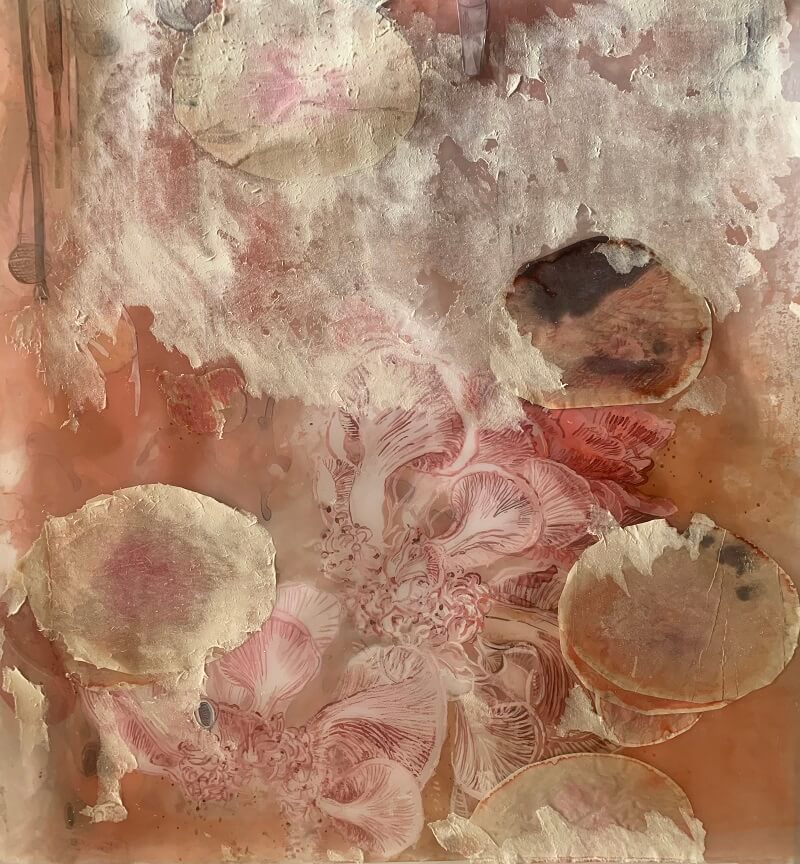
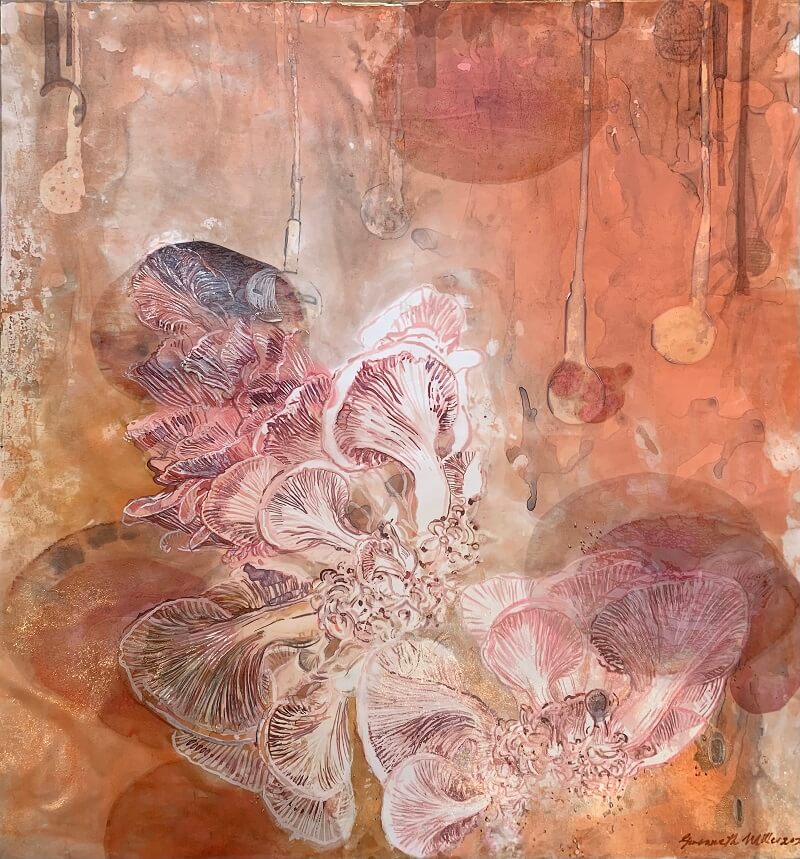
I have since been following her work on IG. On the UNISA university website, I found comments by her on previous work, which build up her body of work for this exhibition:
The transformative abilities of fungi to turn decaying material into a new form of energy, presented a vehicle for visual thinking. Intrigued by the mystery where matter becomes transformed by a species neither animal nor plant, I researched the rich alchemy of mushrooms. This became a metaphor for striving to connect to the intangible. Developing images of the fruiting of fungi, I probed modes of representation to recall the mycelial body in earth or wood and in such suggest a hidden world. Through layering techniques, I searched for mechanisms that can present a sense of obscuring. For example, I used collage at the back of translucent layers and then scrubbed sections off with steel wool. The ink and collage “Mycelium Sound” and print “Listening to silence” both searched for equivalents to articulate a flow of energy that became visible. The latter print is in fact the hidden back of “Mycelium Sound”. Thus the research project, of which the exhibition “Gills of other creatures” was the first, introduced mycelial interpretation through media experimentation. Amongst others, photographing through tracing paper which resulted in prints on rice paper (“Mycelium life” series); drawing with inks on semi-translucent layers (“Mycelium Sound”); and reinterpreting the flow of ink into milky oil paint (“Spores and breath”). Substance coagulation and reticulation of oil paint due to surface preparation, reminded of the alchemical nature of pigment transformation, leading me to rethink my use of charcoal (“Gills of little creatures”). I experimented by fixing grated charcoal and pastel onto surfaces, recalling the powdery surfaces of some mushrooms. The unfolding process thus played an important part in concept development. Sheldrake’s 2021 “Entangled life: How Fungi Make Our Worlds, Change Our Minds & Shape Our Futures”, sensuously describes the immense presence of fungi and the human being’s cohabitation and dependence on this ecosphere. The mycelial mesh is an entangled realm beneath us, surrounding us – some even living within us. “Life is at the root tips” pays homage to mycelium growth and reminds us to live in the present. This work overlaid an earlier work (“Mountain Karee for Stefan”) with drawings of mushroom growth, urging recovery. I’m further influenced by Haraway’s (2016) “stories that gather stories”, as she links ecology studies and future fantasies to argue for complex systems and interspecies relationships. I find solace in the lingering thought that we are communities of being, actively immersed in various life-worlds. This porous boundary is expressed in the abstractions “Spores and breath” and “Gills of little creatures”. The h-shaped structure of the overall installation, with its central ‘bridging” shape, was an intentional hint at the Periodical table of elements, a contemporary schema of knowledge. Hillman’s (2010) lectures on Alchemy contextualises much older wisdoms of thinking, and reminds us that metaphors of alchemy hold useful lessons for our psychological understanding. My work titles “Metabolic alchemy” alludes to this context, whilst “Underbelly” speaks to the vulnerability of life (soft underbelly) instantly transformable by the trauma. Fourteen works in total were installed: Eight digital works, three oil paintings (of which one is a triptych), two ink drawings and a mixed media (monotype/charcoal/collage) drawing. They formed a substantial contribution to the group exhibition “Uncanny Stories”. In the curatorial brief of the group exhibition “Uncanny Stories”, I wrote “Making art often includes searching for the tensions between known and unknown, between ordinary existence and intriguing events that write peculiar new stories into our lives.” My works are about thinking how life continues beyond distress and how the complex biology of our own emotional being as hidden as fungi’s energy. The lines of mushroom gills echo the folds of our synapses where memory is buried. The work contributes to narratives of trauma and eco-aesthetics, aimed at finding metaphors for interpreting life after death not only as sorrow but as gentle resurgence.
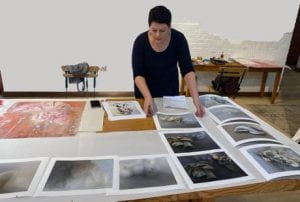
She uses photographic images to develop ideas, as well as working with physical fungi which she collects. She is also intrigued by the spores; to her, it becomes a ‘soup of micro bits’ that inevitably surrounds us. I can completely identify with this – I have many spore prints in my studio. I do like the idea that fungi as a theme can be extended. For this artist, it became a metaphor for both tangible and intangible bonds. Looking at the visual appearance, mycelium is a mesh and entanglement but hidden under the ground. We know relatively little and need to search for more understanding, and this is where I find the possibilities of creating new work – a type of link to search around a meditative practice and nature. I also think this talks to alchemy or ‘magic’ when one considers an interrelationship between stuff and us, our communities, and our friends. Spores fascinate me.
In a recent exhibition at the university, she continues her exploration of fungi when she explores listening to what is underneath the surface. Her works come from an ecological space and make one consider our relations with the earth and each other. Having been in contact with her via exchanging messages on IG, I have learned that her work has a meditative practice of being in nature and contemplating loss and death. It is clear mushrooms are the ideal subject to use. She became interested in my collaboration project – the final stages where I am attempting to get mushrooms to consume and break down the work into the soil. It made me aware that as a project, this process could lead to new work if mushrooms continue to grow on the work or, later, the area where it was placed.
MAKING
Through a process of initial exploration, experimentation and practical research make several pieces of developmental work. This work will form the beginning of your body of work.
I start in my sketchbook and explore ideas for holding mushrooms in my hands. My inspiration comes from a recent work made with drawing and mushroom spores. It is the end of the season to forage for mushrooms, and I contemplate the material I have gathered and how to take this process further. I feel there is insecurity in this place, as my ‘material’ will not be so freely available, and I will have to consider other ways to explore my making process. I will continue to grow mushrooms. I have mushroom ink in my fridge and lots of spore prints I have been making. Care is still very much part of my thinking. I started to draw with ink from mushrooms and then worked Cretacolor pigment powders into areas; here, I used charcoal powder and sepia powder. I want to capture my hands in the work and create a more extensive painting.
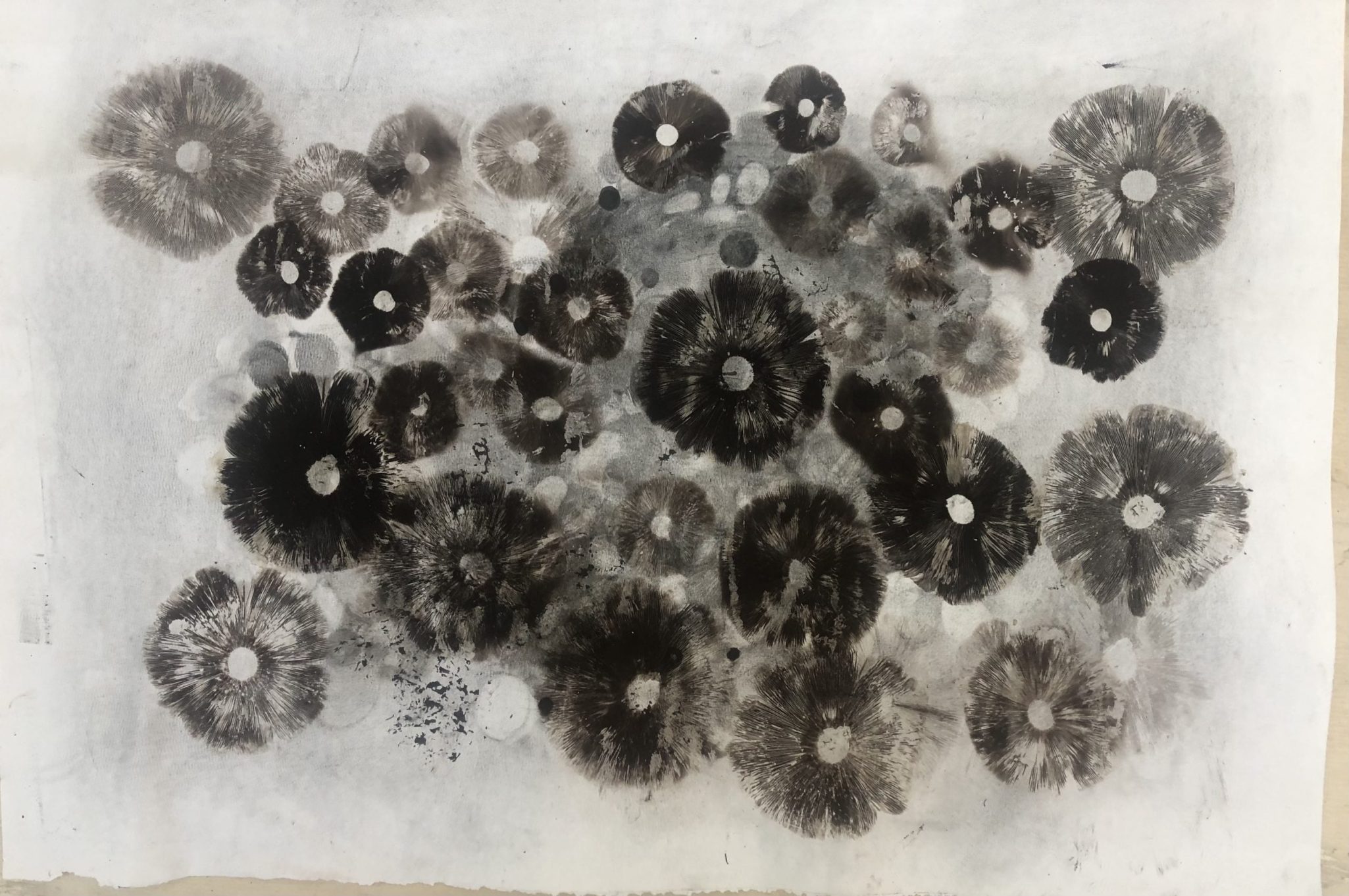
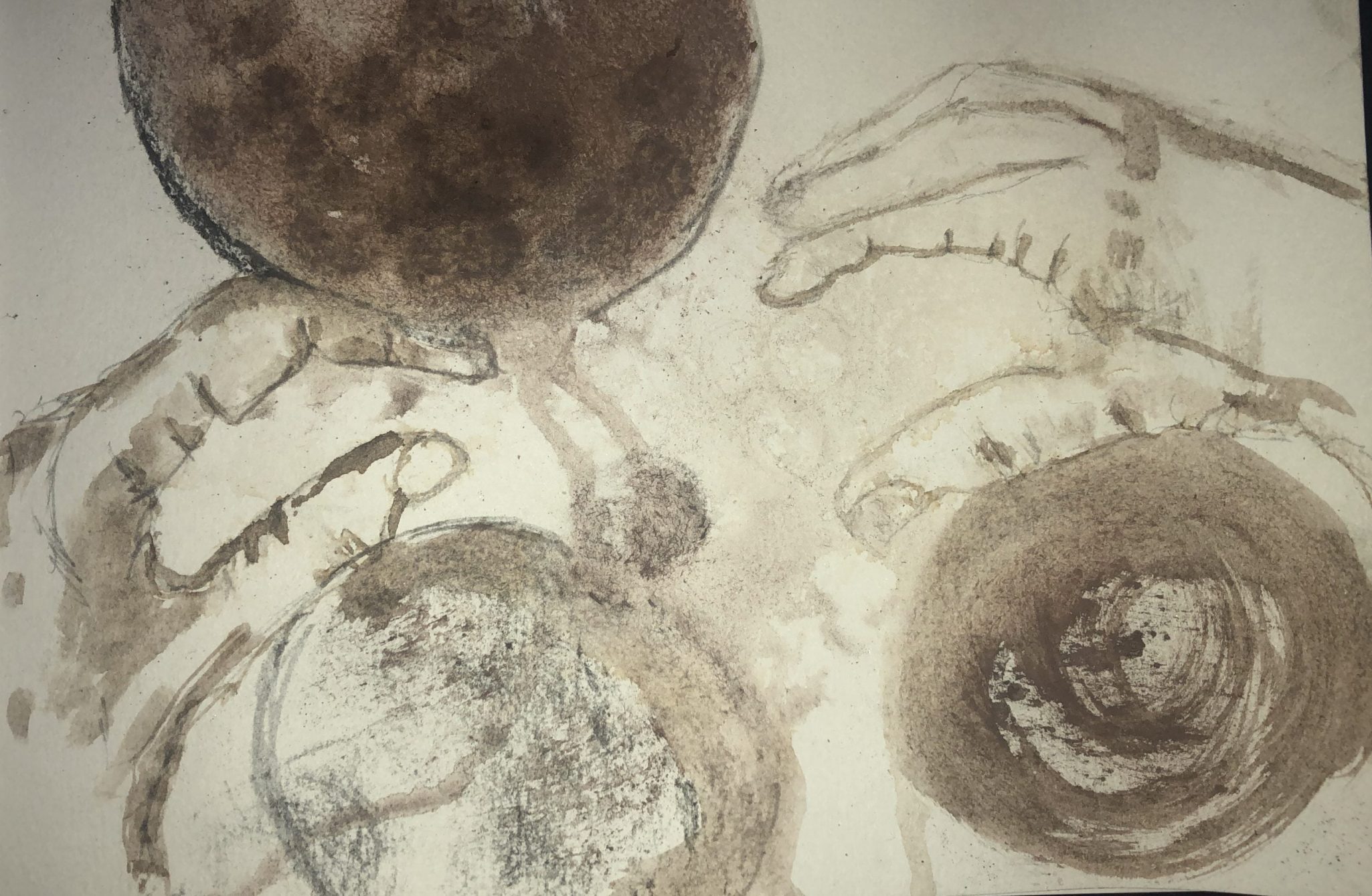
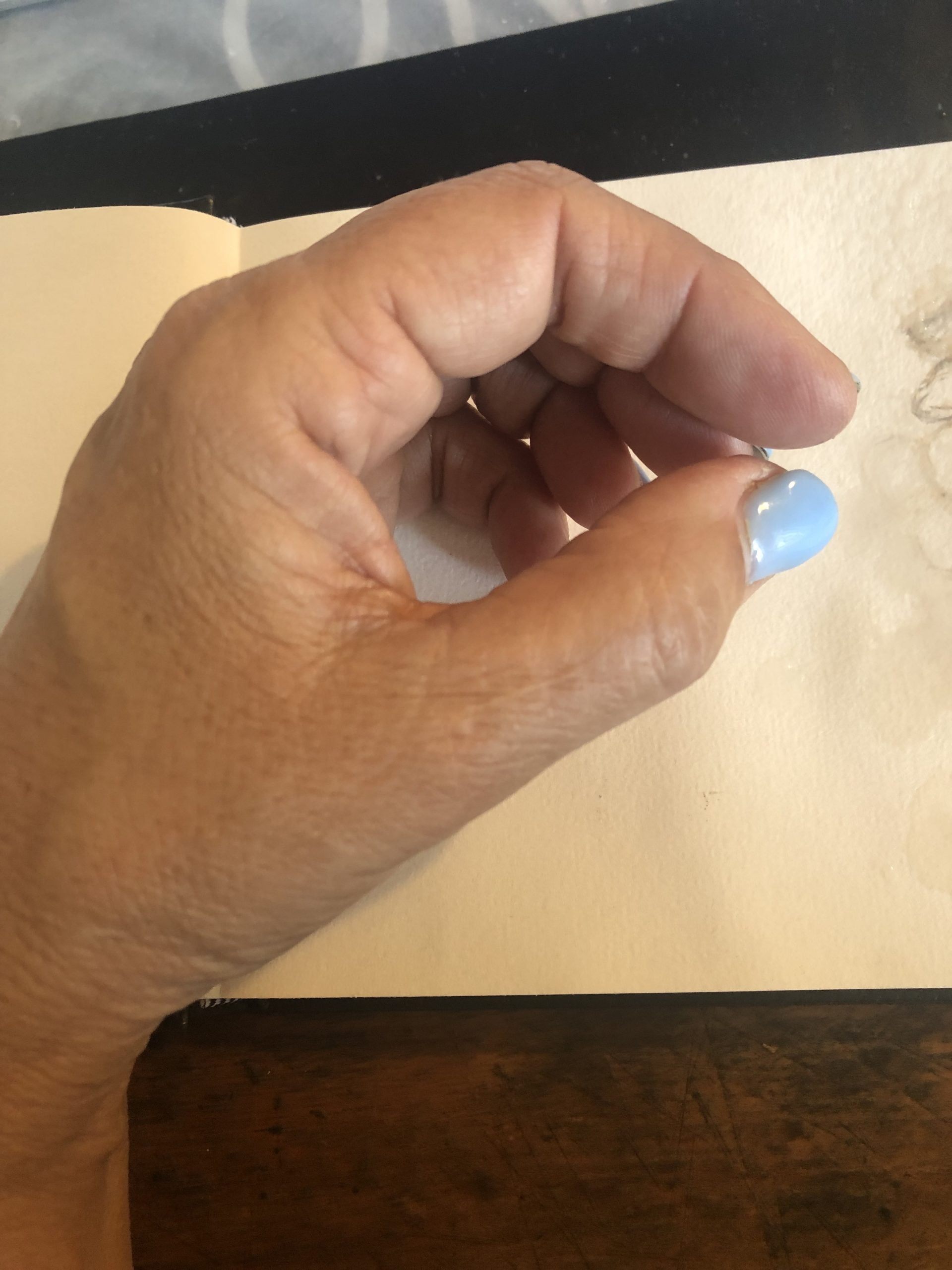
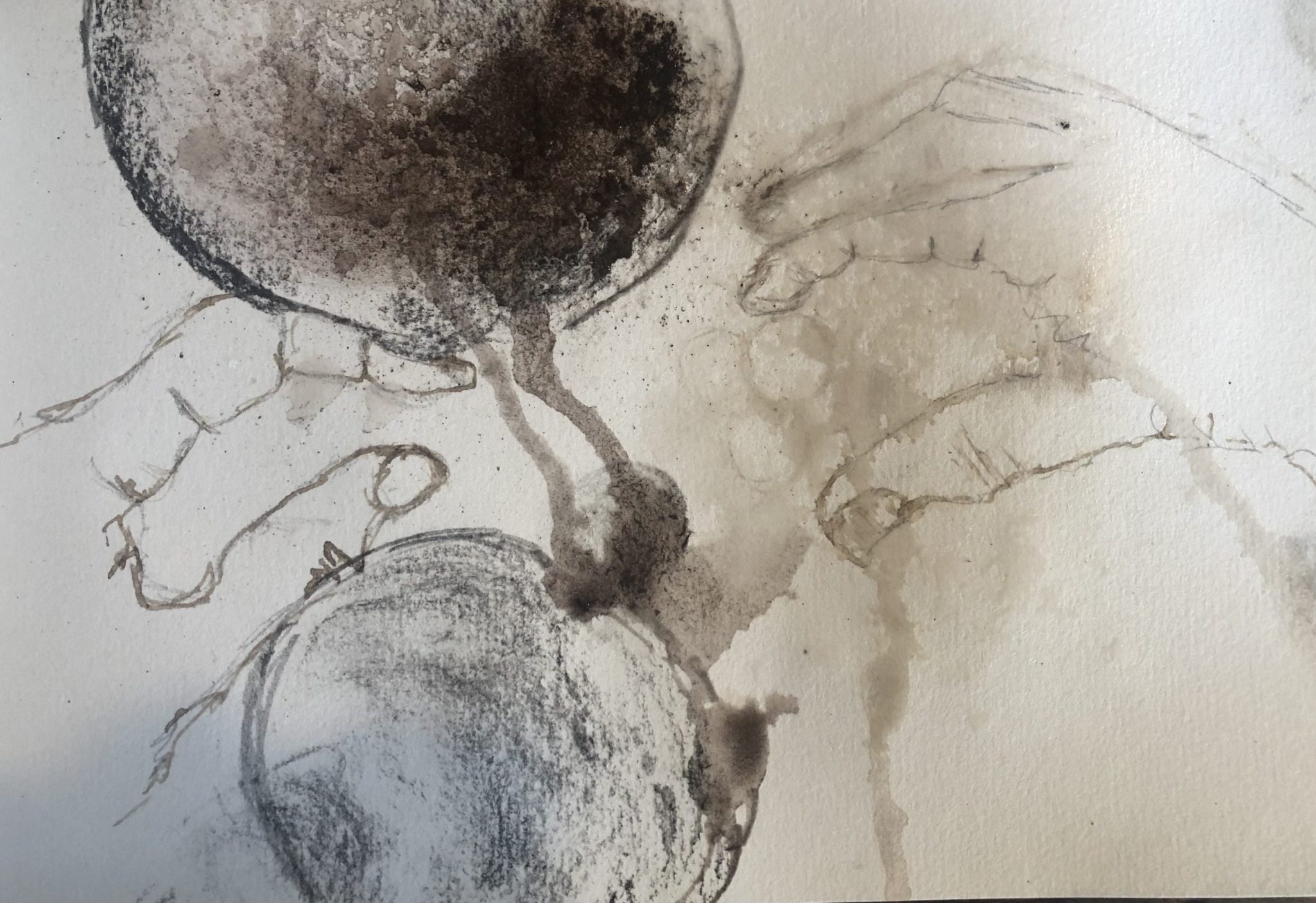
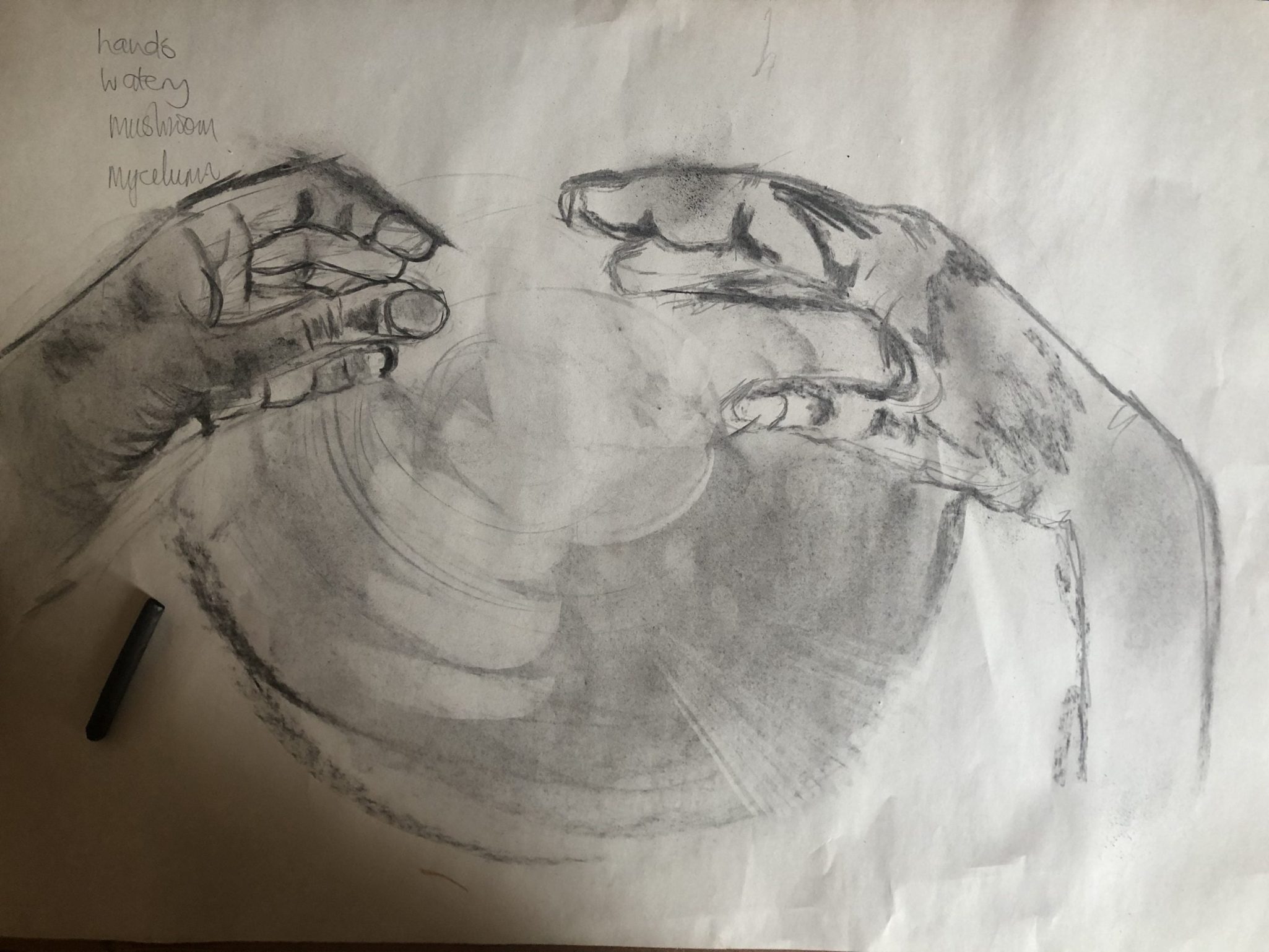
I attempted to do cyano-type printing on paper I had prepared a few months ago. The work varied in outcomes. The prints were made with fresh mushrooms onto the prepared paper, seeking if the spores would drop onto the paper, and then I could take it into the sun for imprinting into the paper. All looked well to take outside. With the rinsing of the first print, all the spores washed away, and I was left with no copy of the gills of the form, see image. I decided not to rinse the rest.
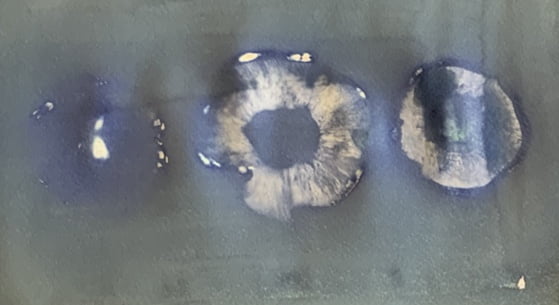
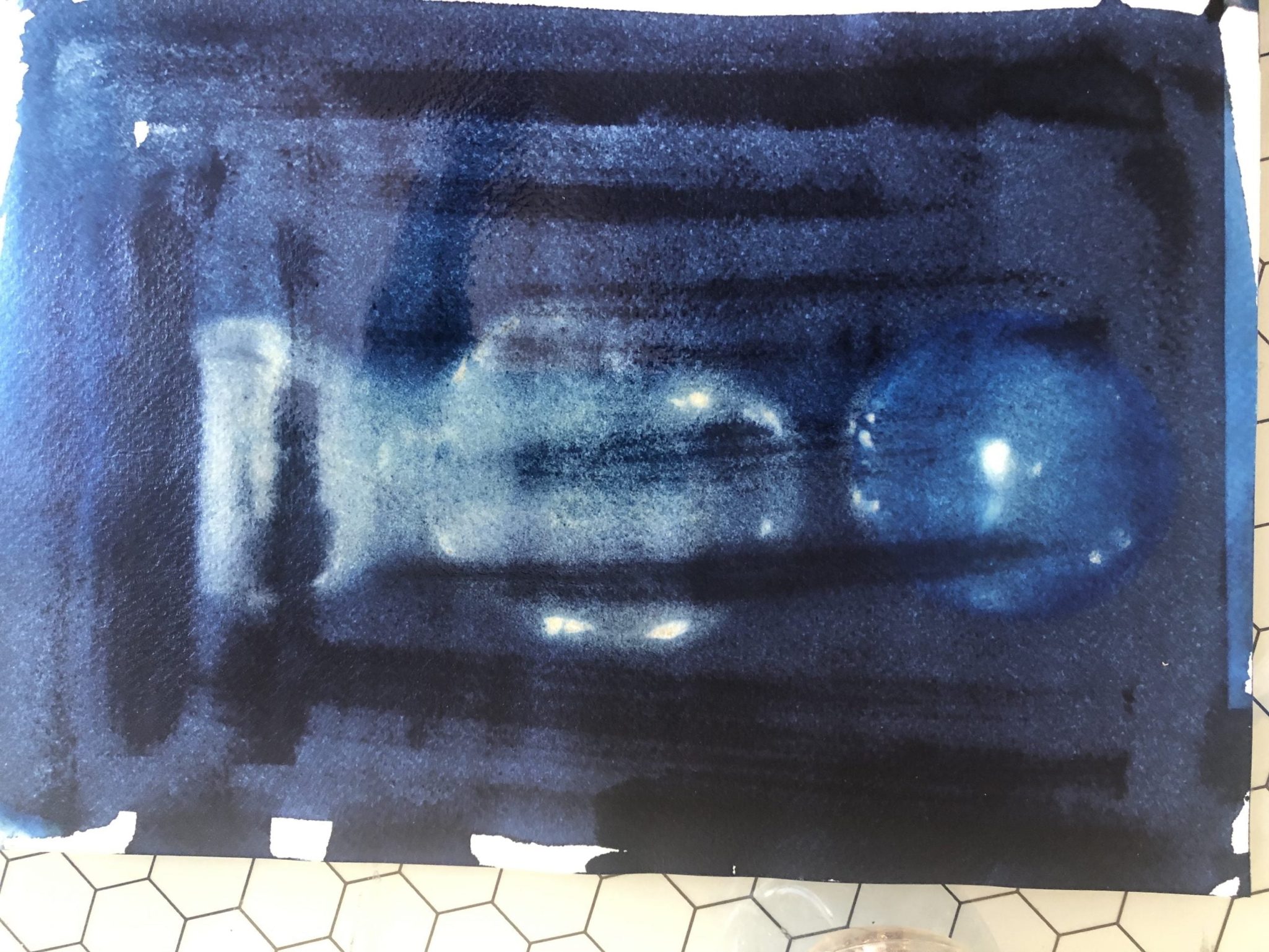
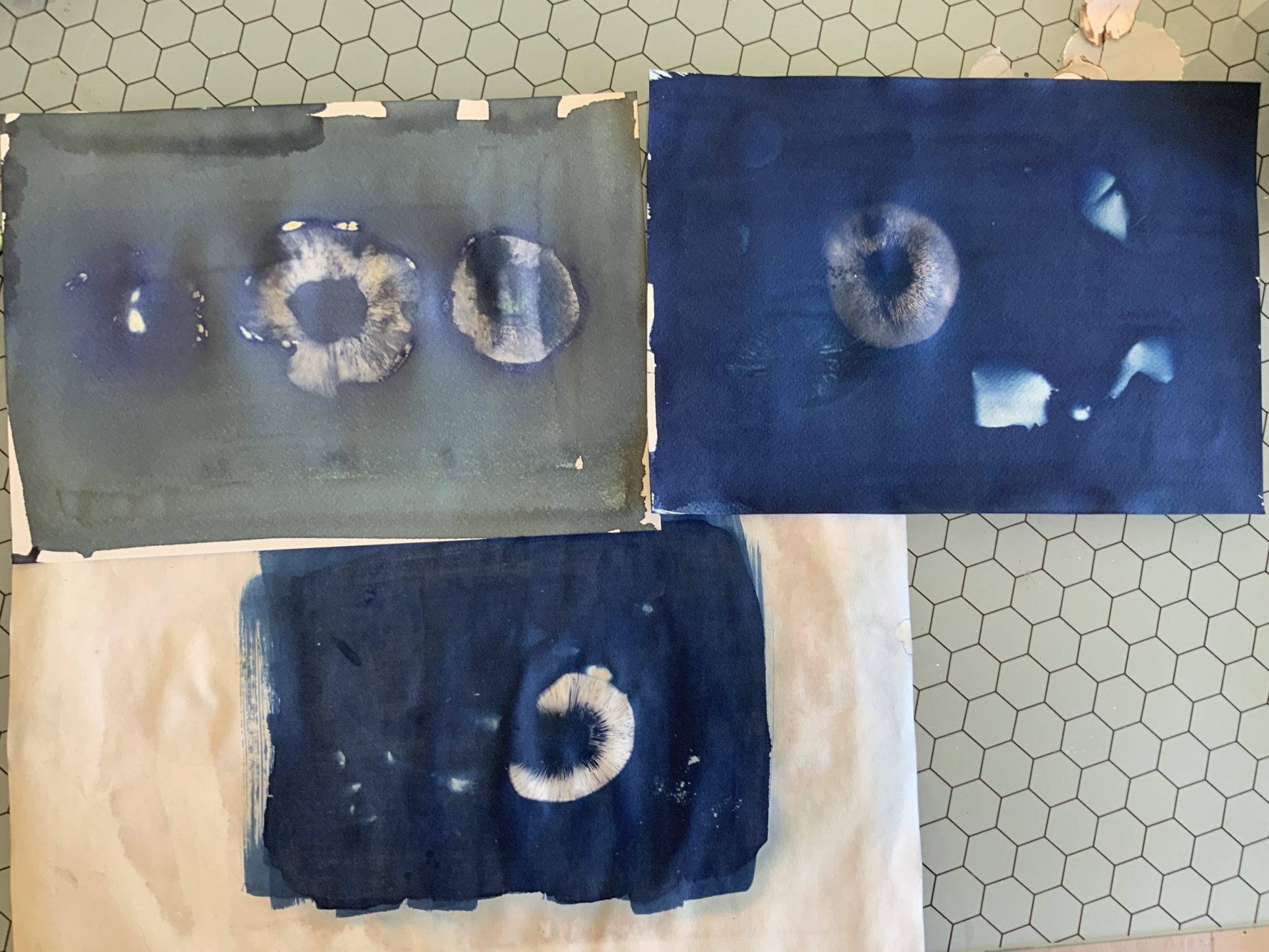
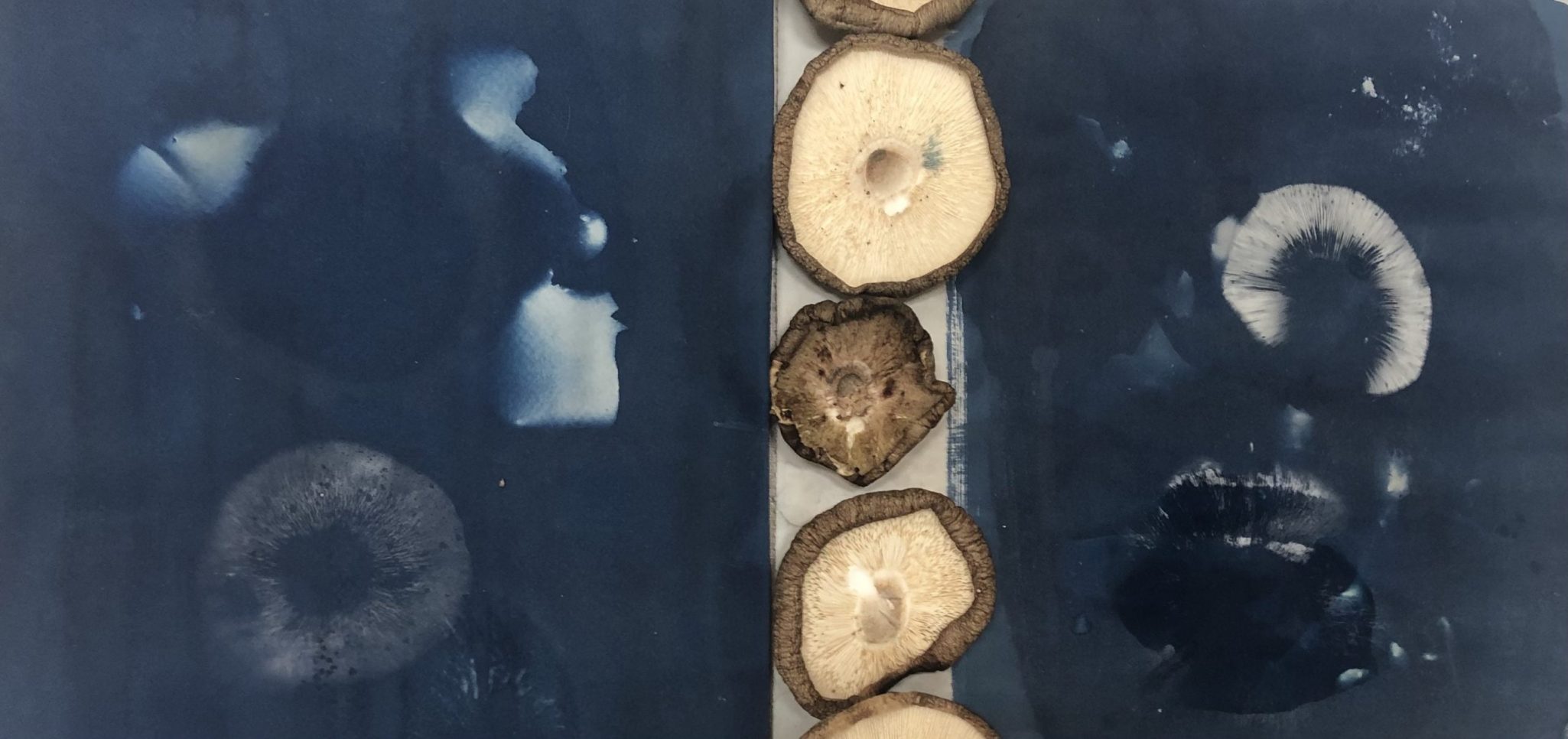
More attempts with cyano printing followed, but I am not satisfied with the outcomes. I used an imprint on paper and fixated with fixative spray in this work. I covered the paper with the chemicals and then left it in the sun to fixate whilst it was still wet. It was windy, and my attempt was not good enough to validate this method. I will have to experiment more with this.
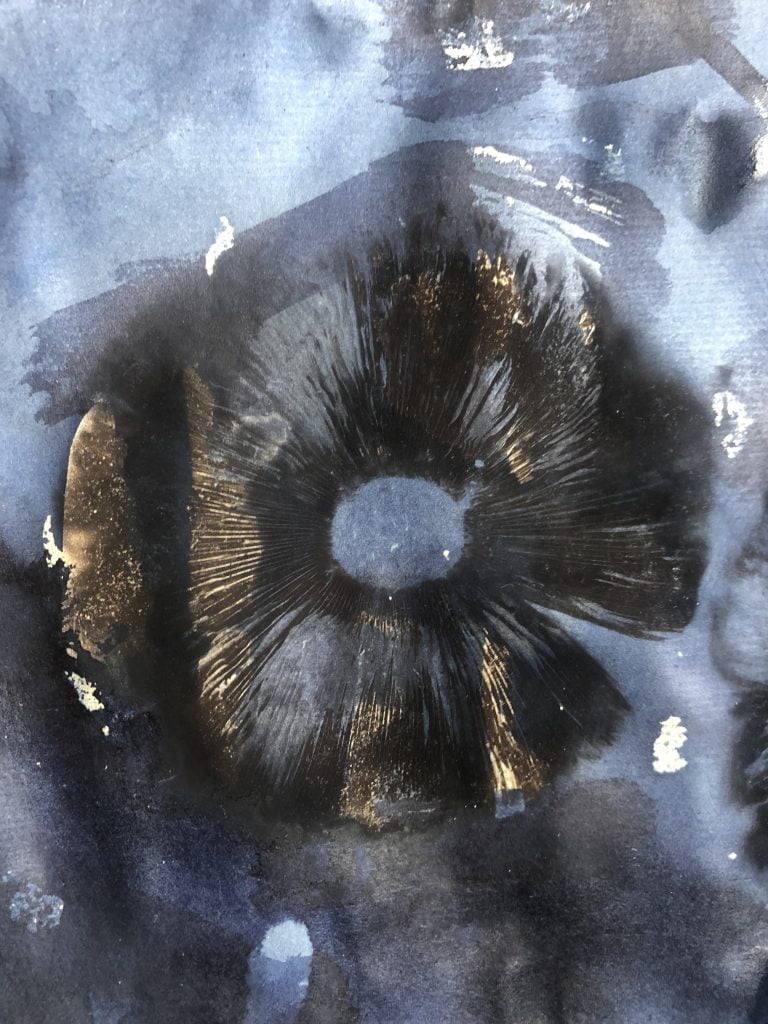
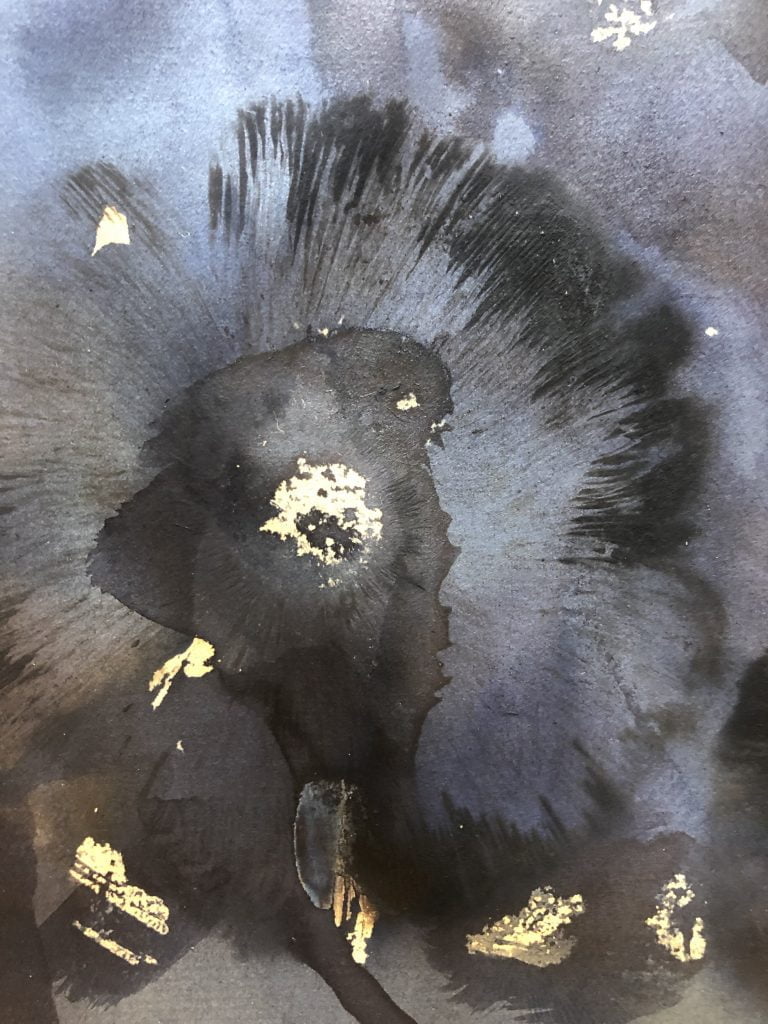
In the works below, I worked on a jelly plate and used dried mushrooms for their skin and shape. I worked with an oil printing medium to do the first six images I shared below and made the prints of different coloured paper supports. I also did two monoprints with an acrylic-based white printing medium to explore further use of these objects, thinking of working from images I have already made or used as the springboard for new making. I worked on paper as well as velour paper for these two images.
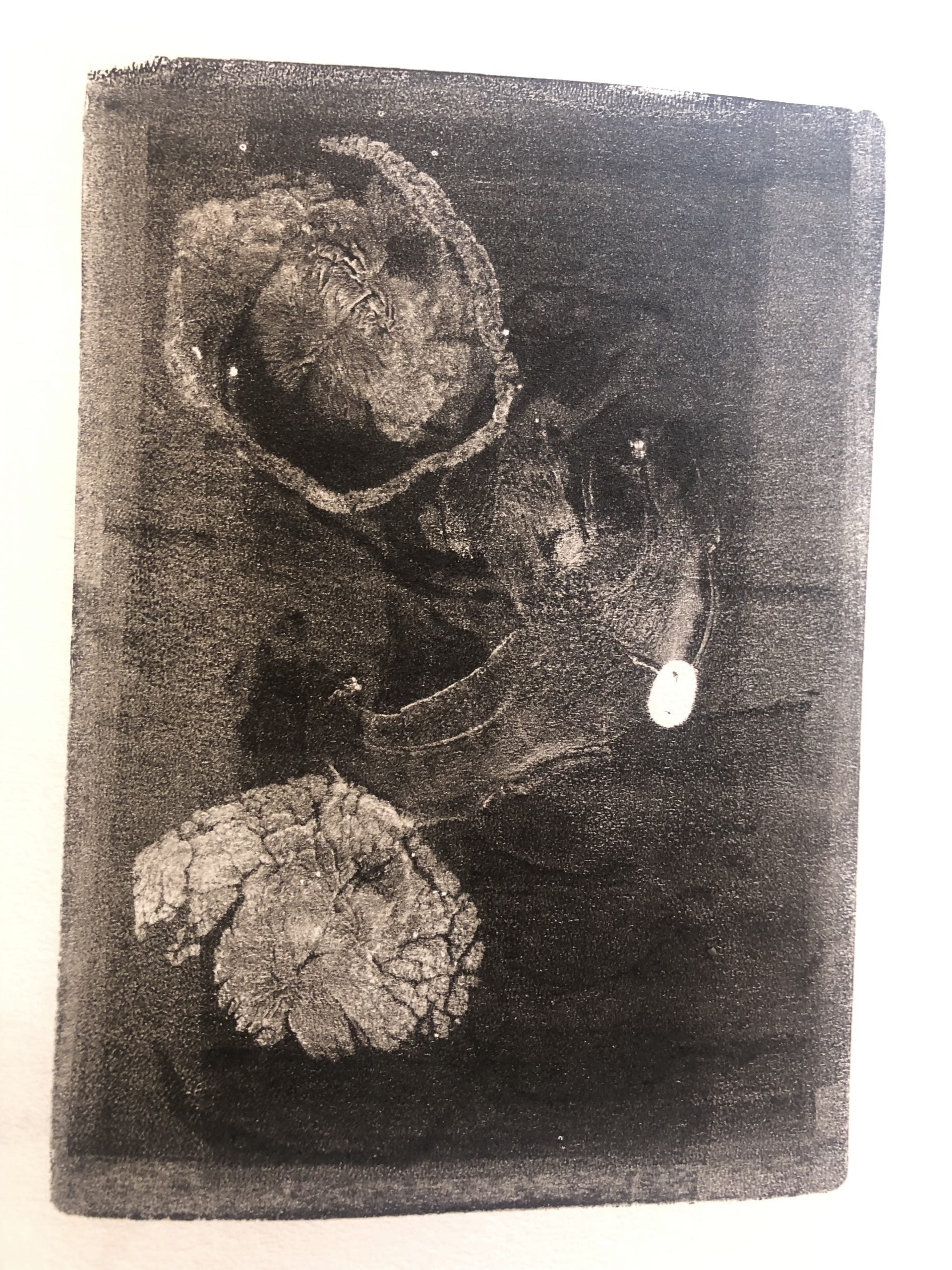
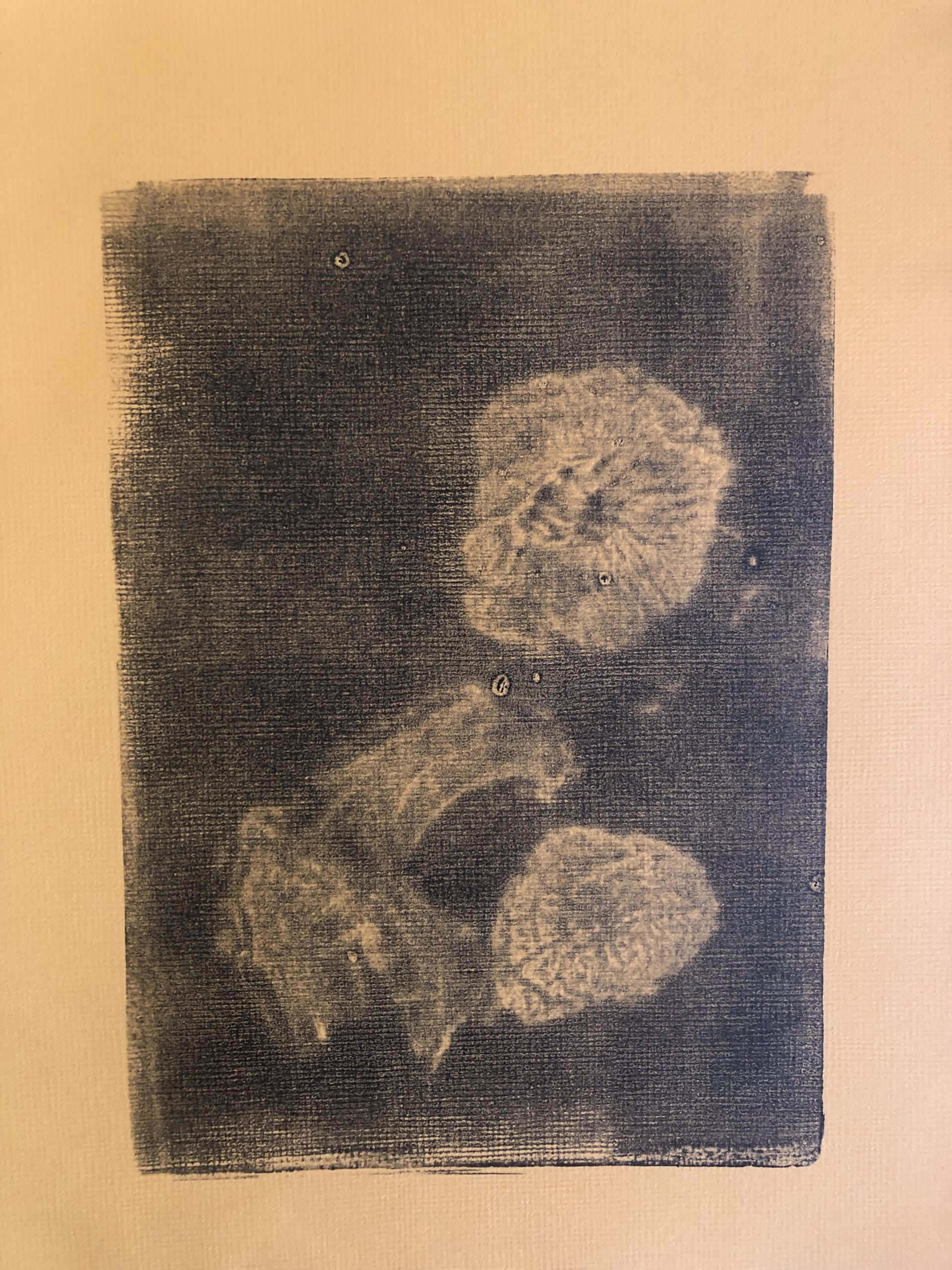
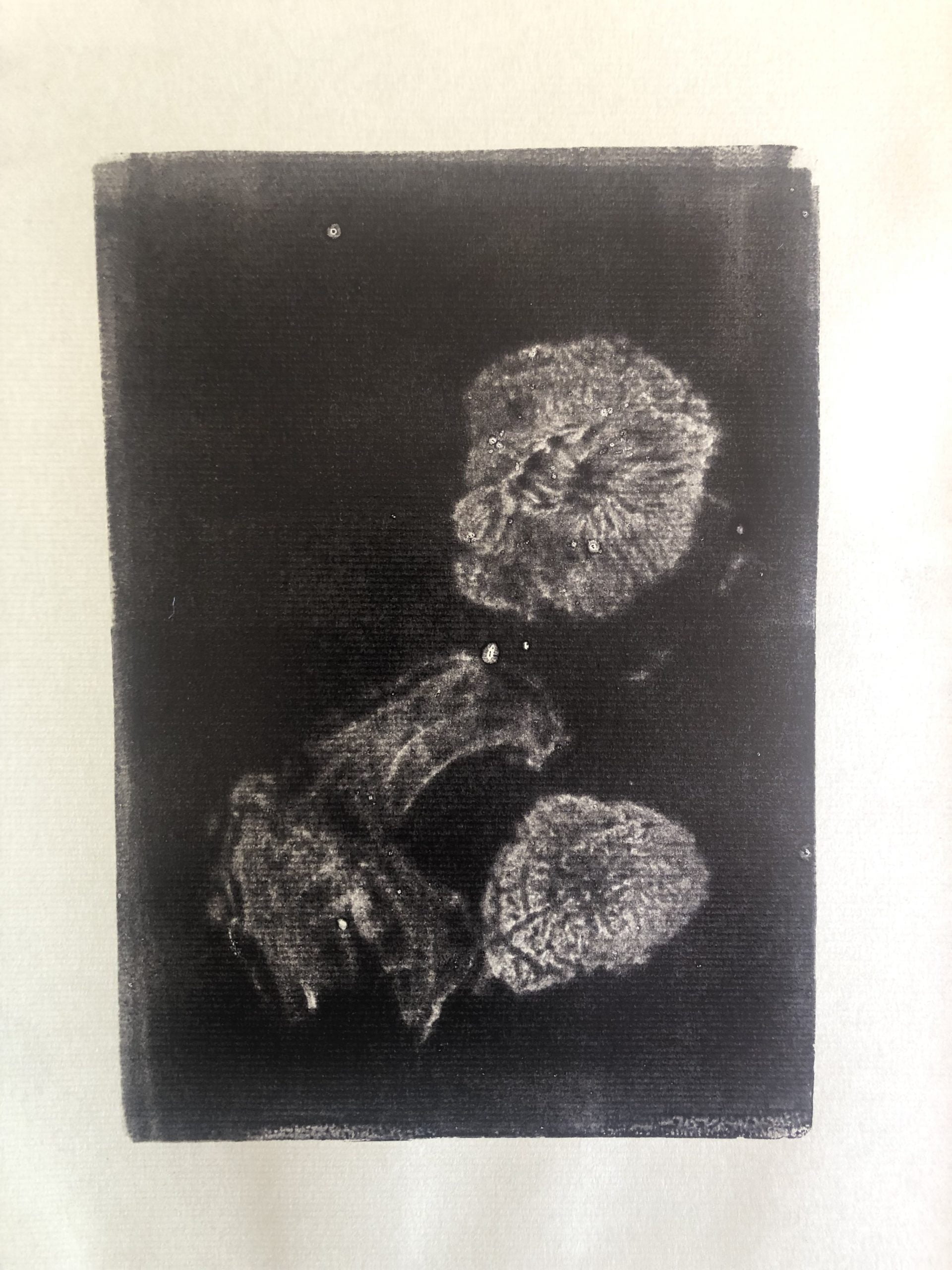
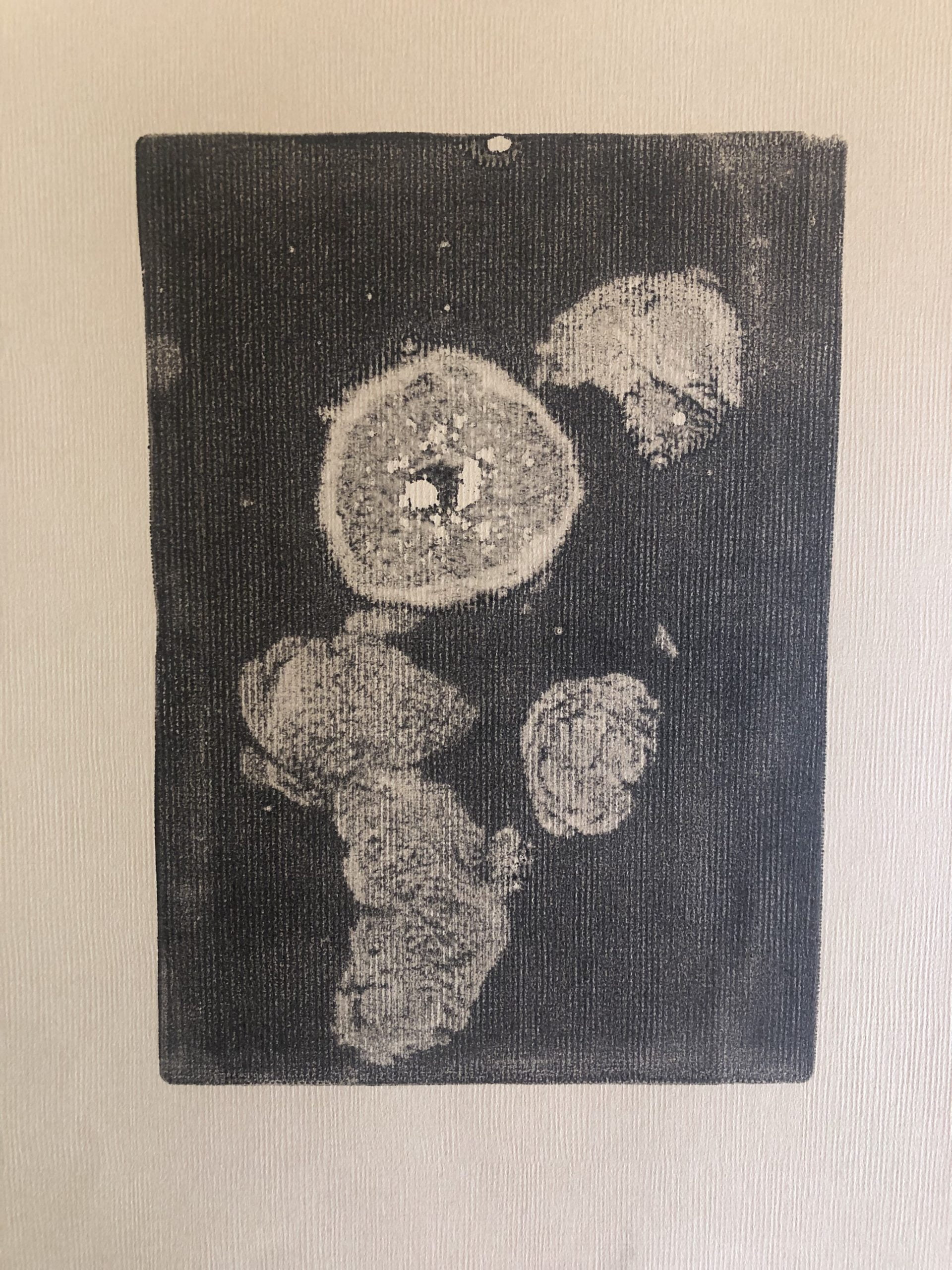
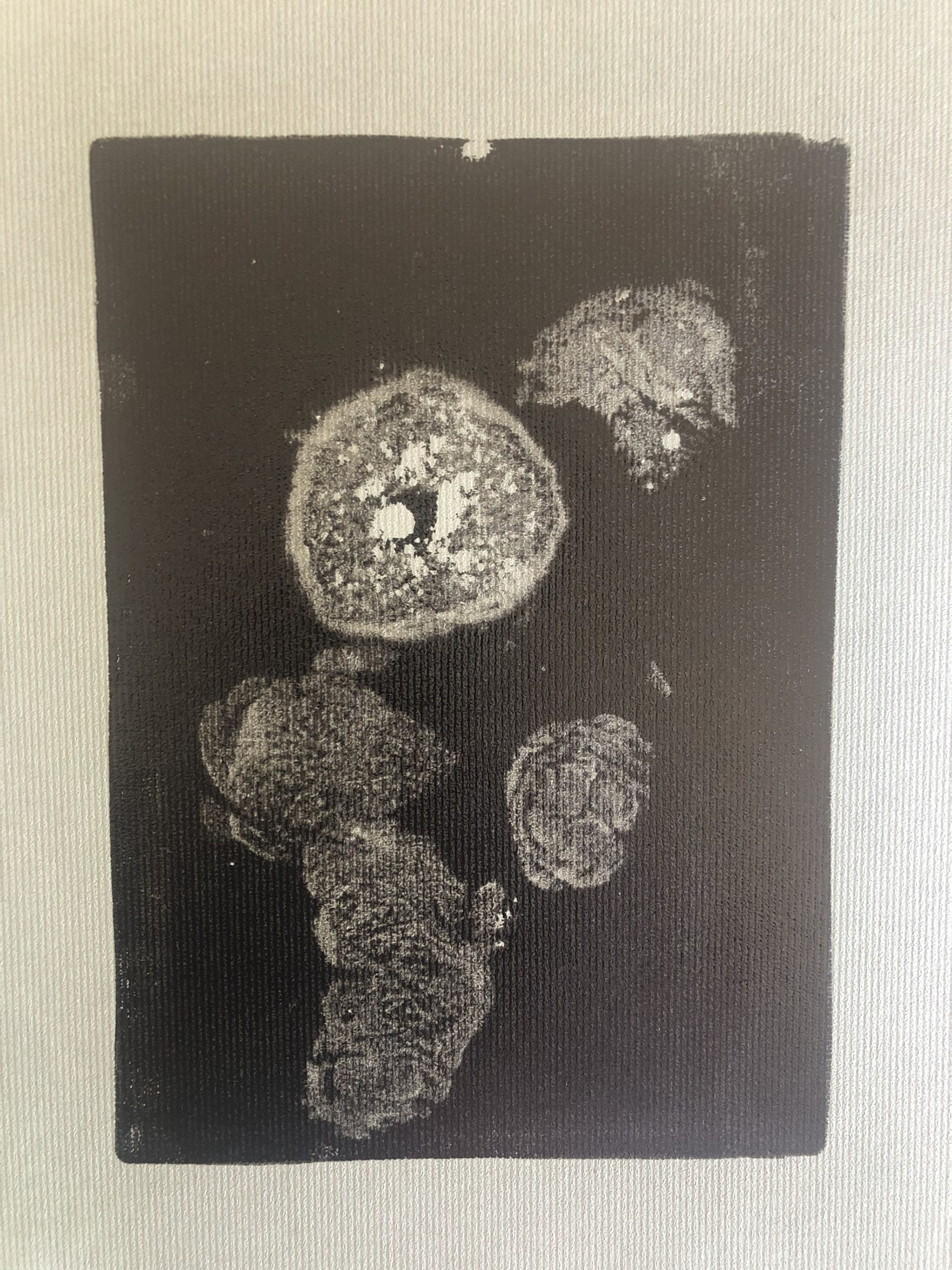
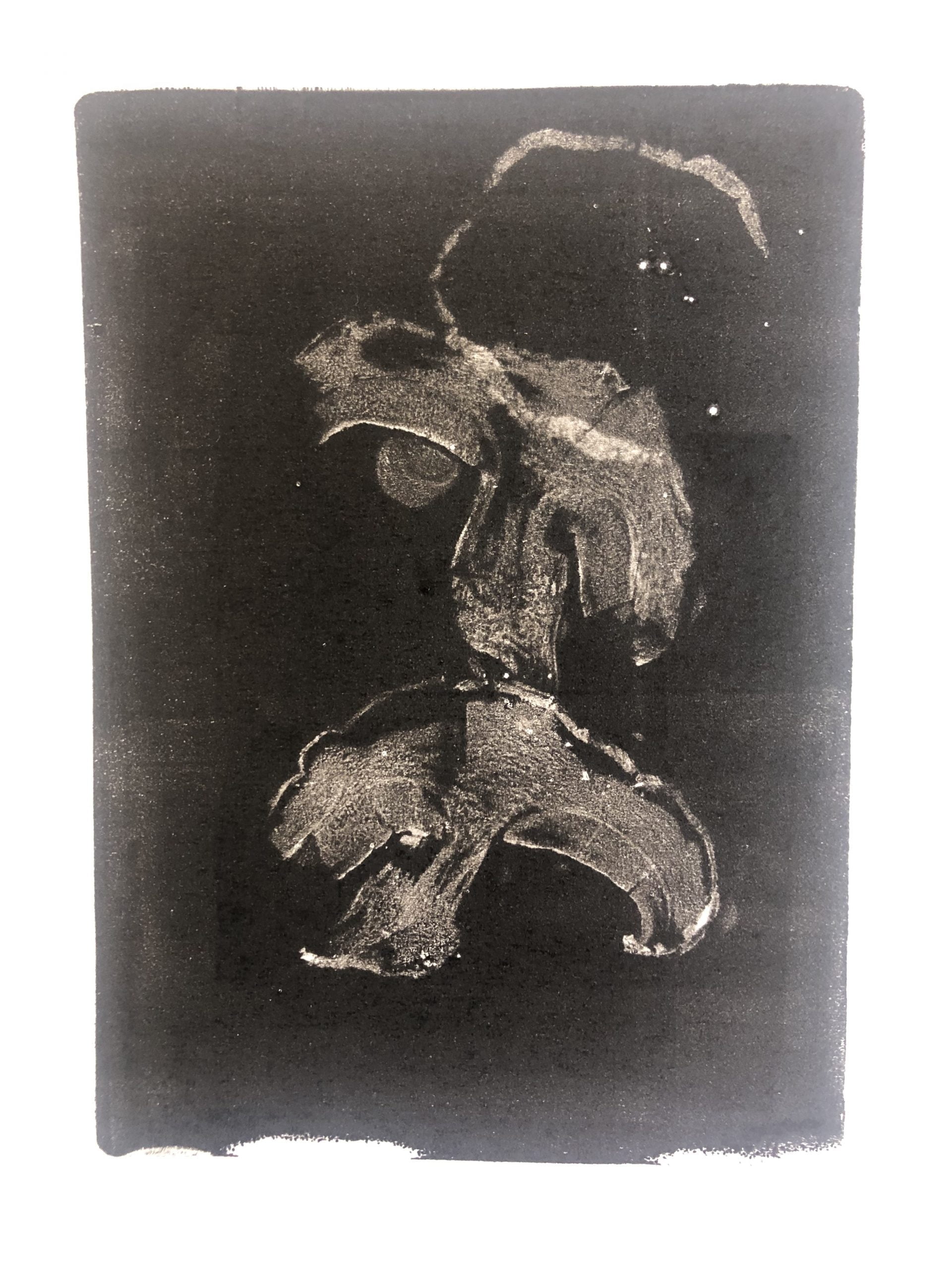
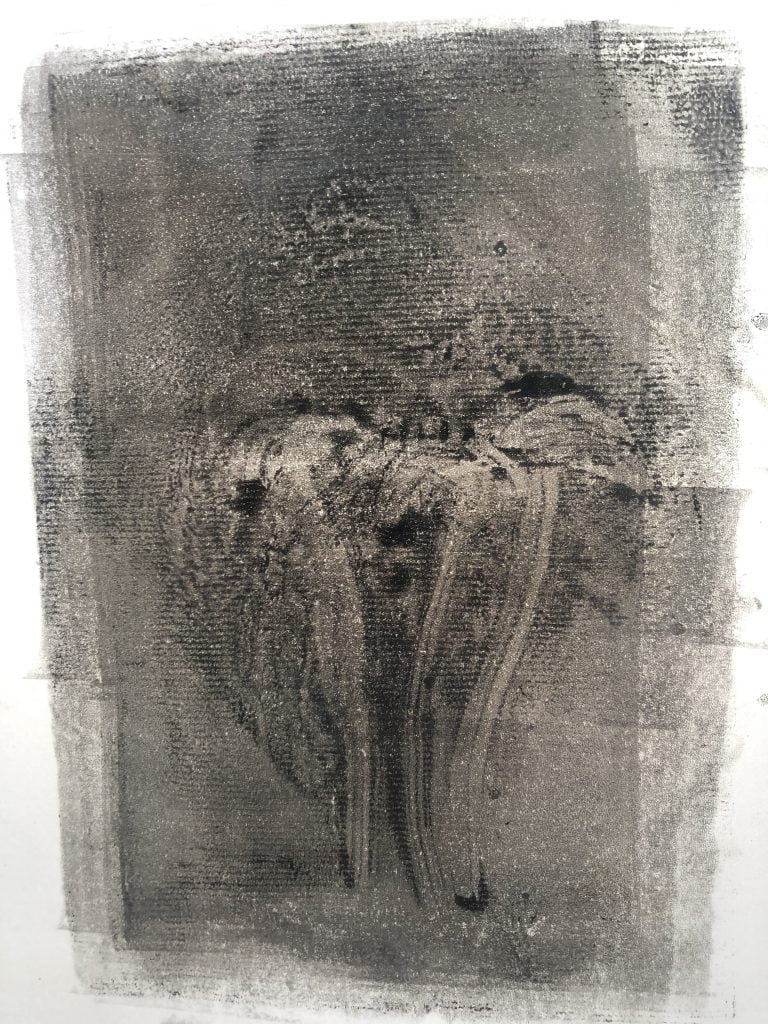
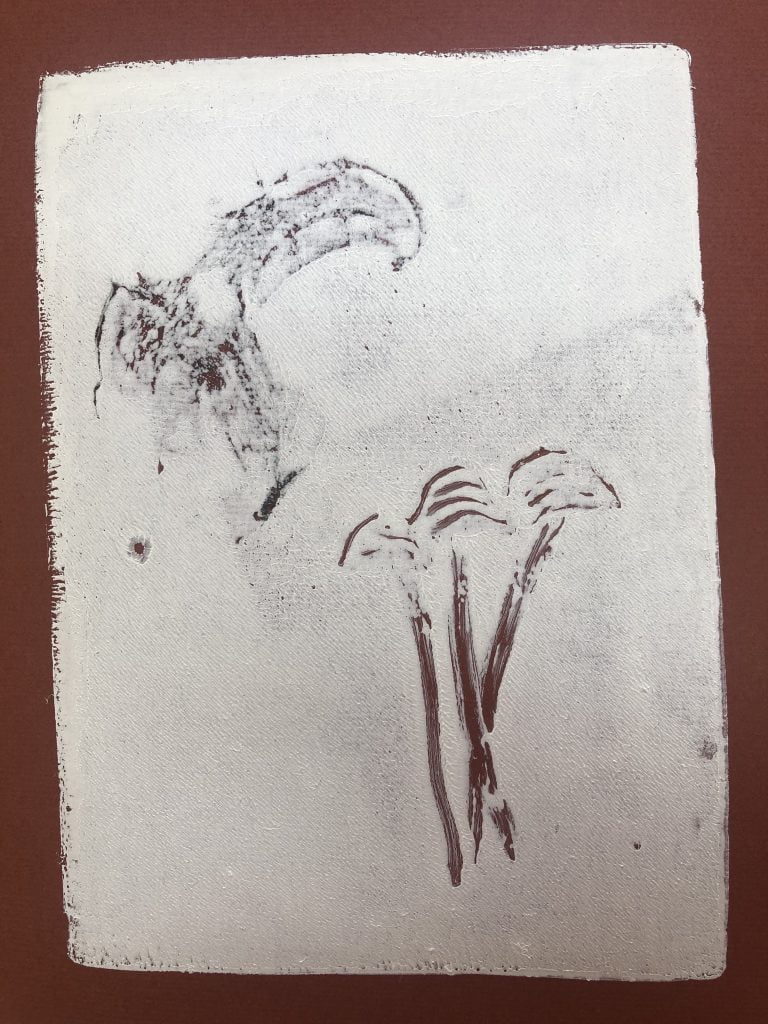
I did more drawings in my sketchbook to explore the form of mushrooms by creating a charcoal layer and then erasing the form. The last two monoprint attempts inspired these drawings.
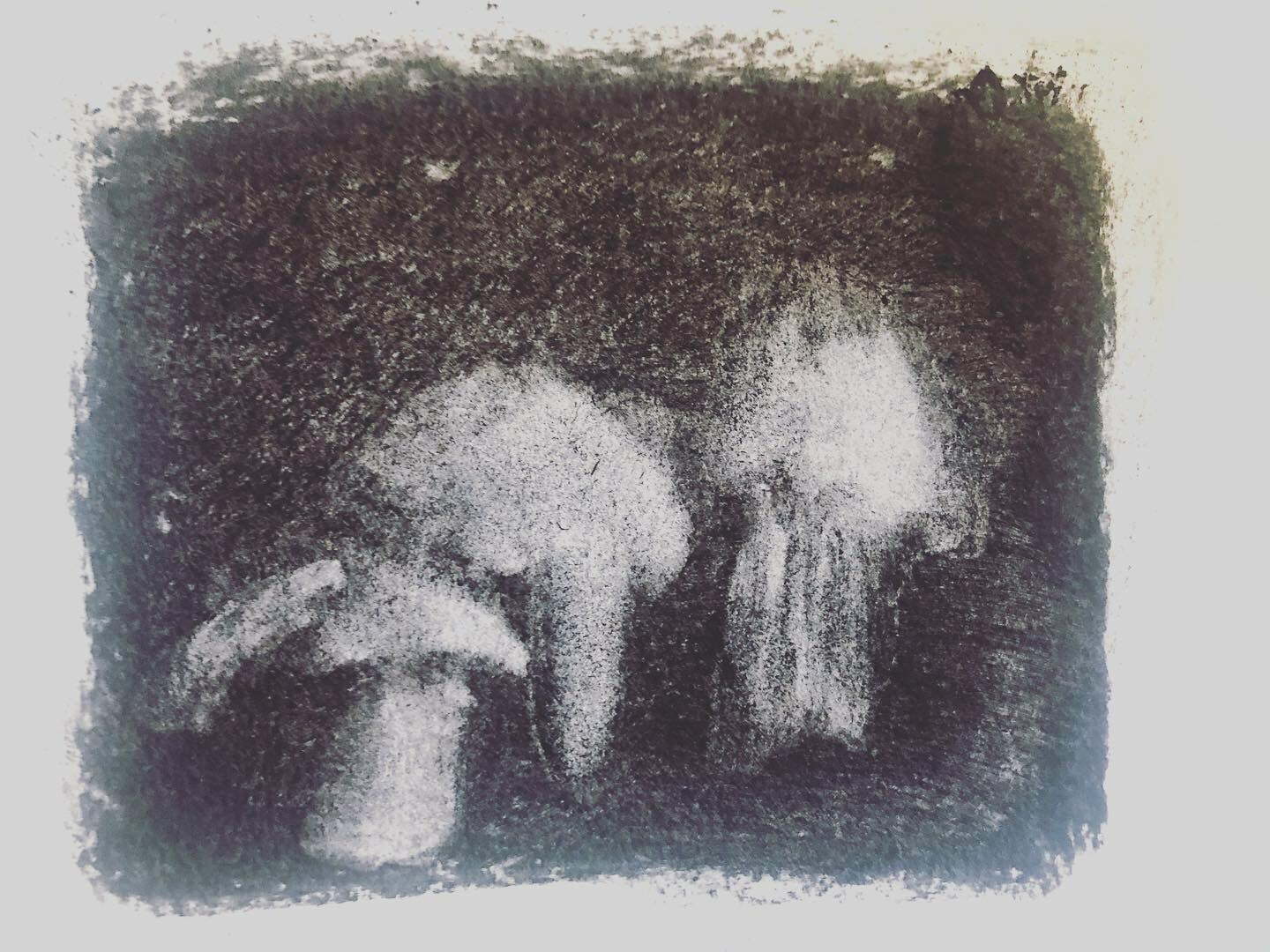
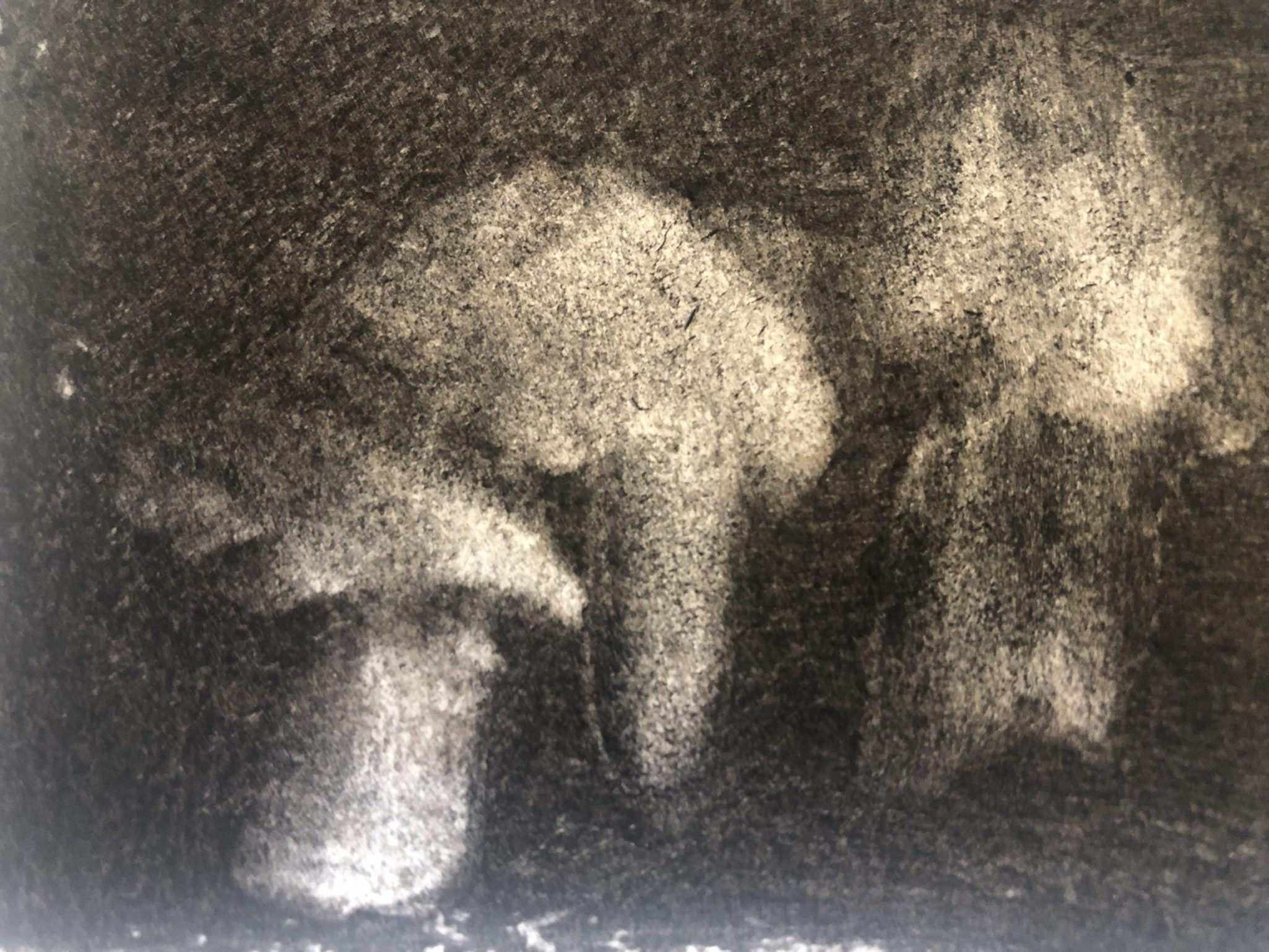
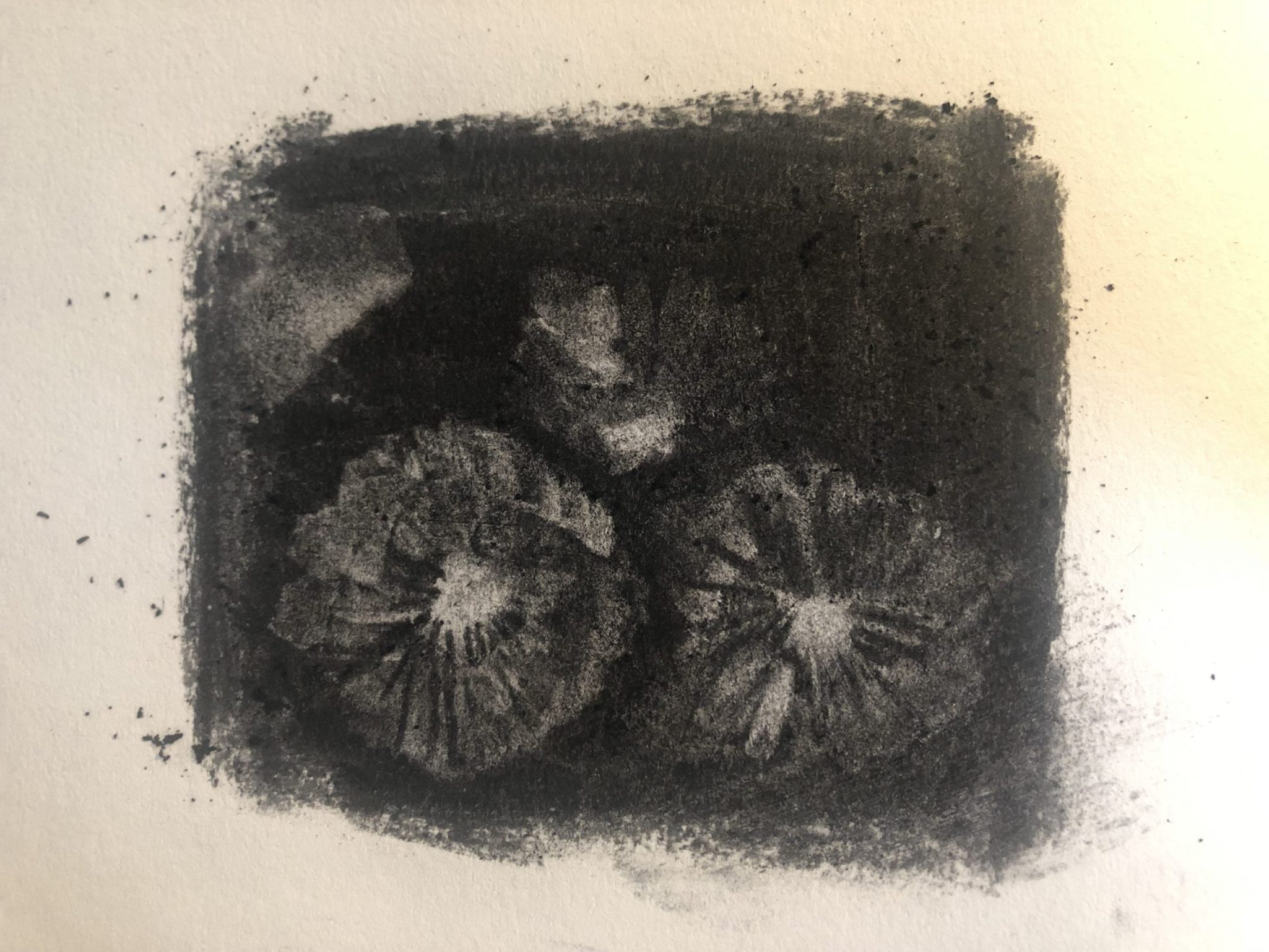
I think the potential of this work is in the atmosphere of these drawings. They remind me of fleeting time and have an aesthetic of a print or old photograph.
I made other drawings where I had to add white chalk after I sprayed the surface with a fixative but felt the shadows of the mushrooms did not show well enough on the ground made of Sepia Powder. I see this as the last mushrooms of the season – picked on the lawn earlier that day, just before the grass was mowed. I look at these sketches as a form of documenting different species of mushrooms I have come upon. I like these as they are so dainty, but also the beautiful shadows they cast on the paper support. I added a video that captures more than just the work and the sound I was surrounded by. I have been considering sound in my work for a long time and would like to explore this.
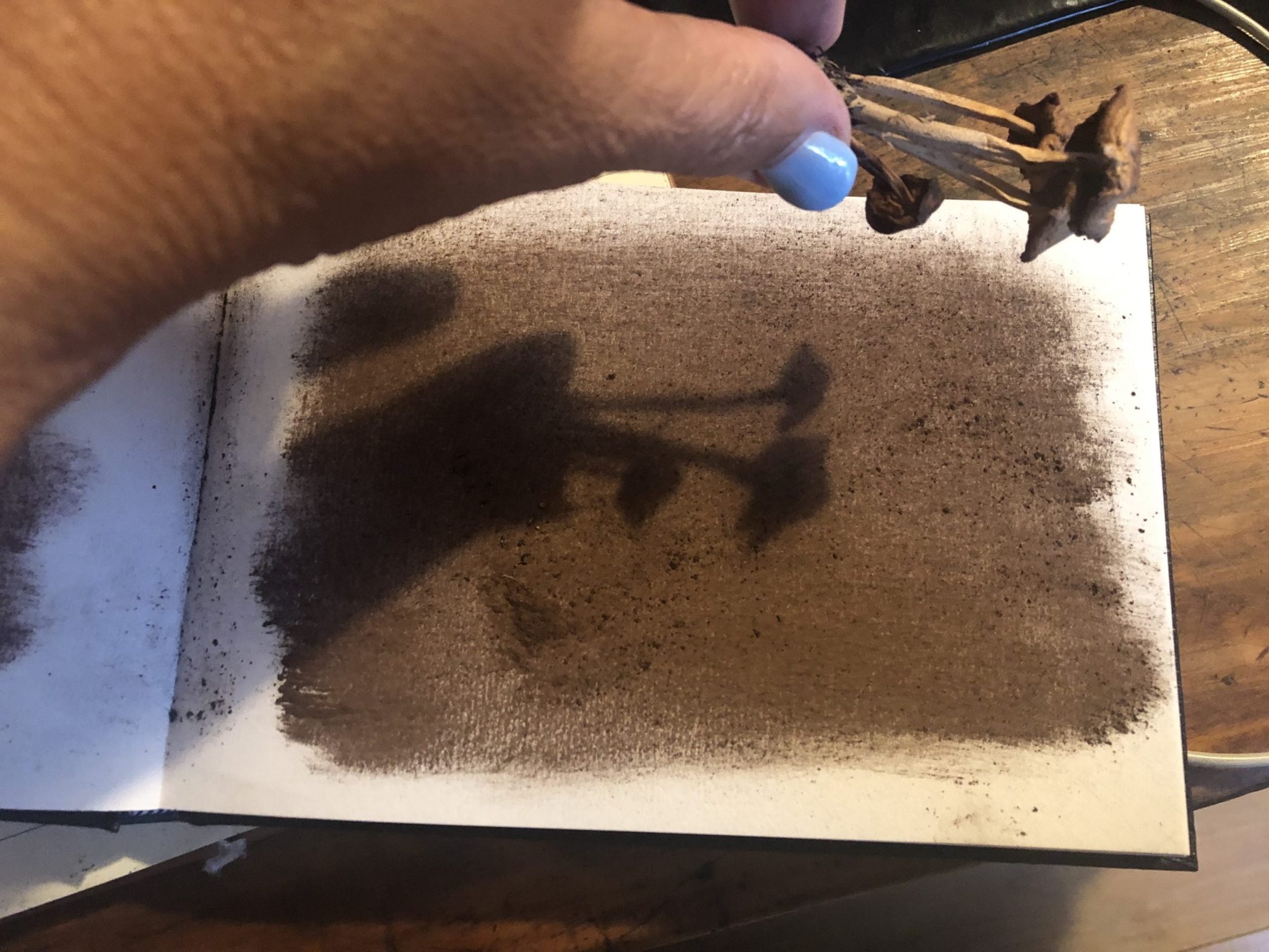
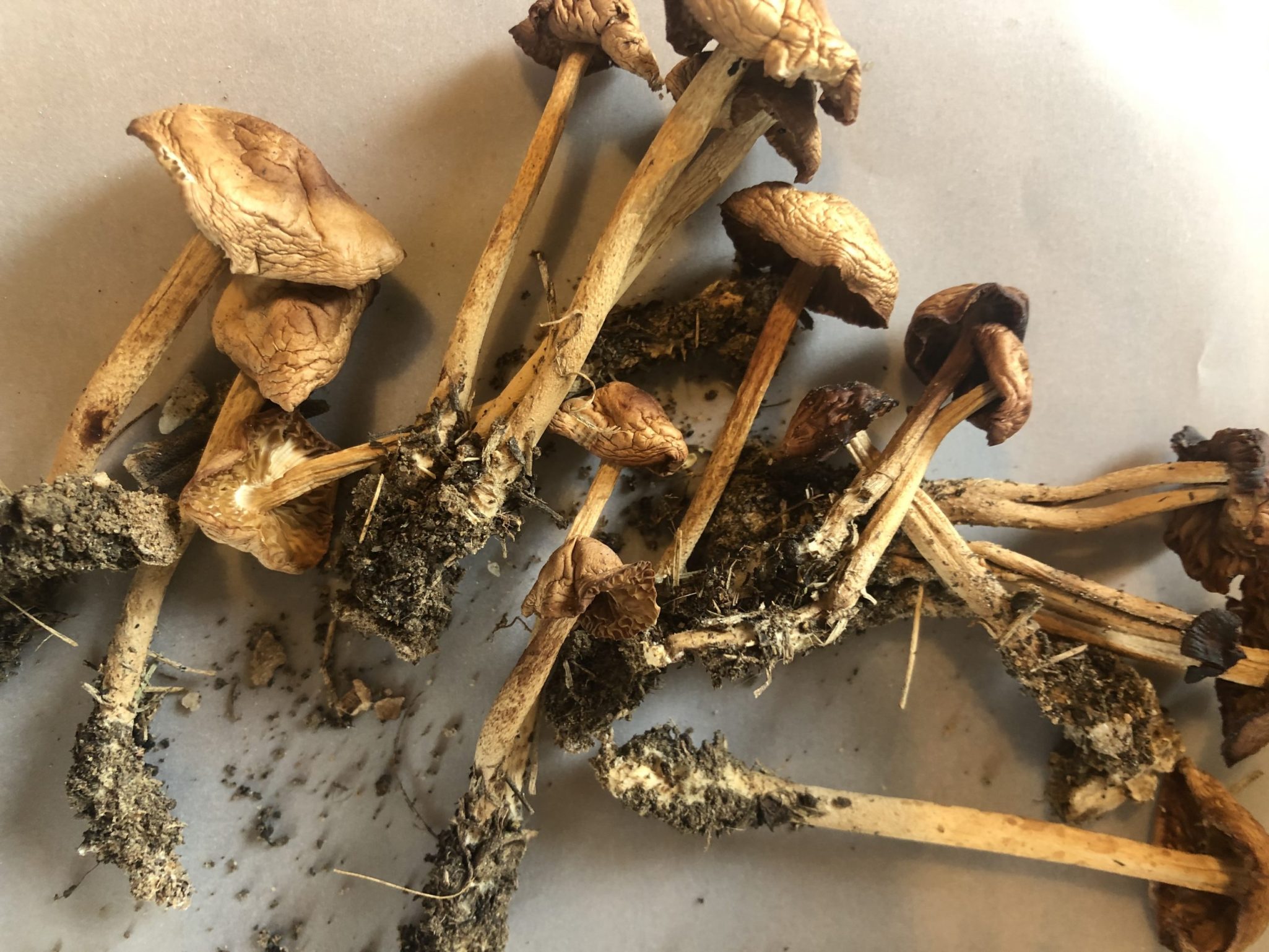

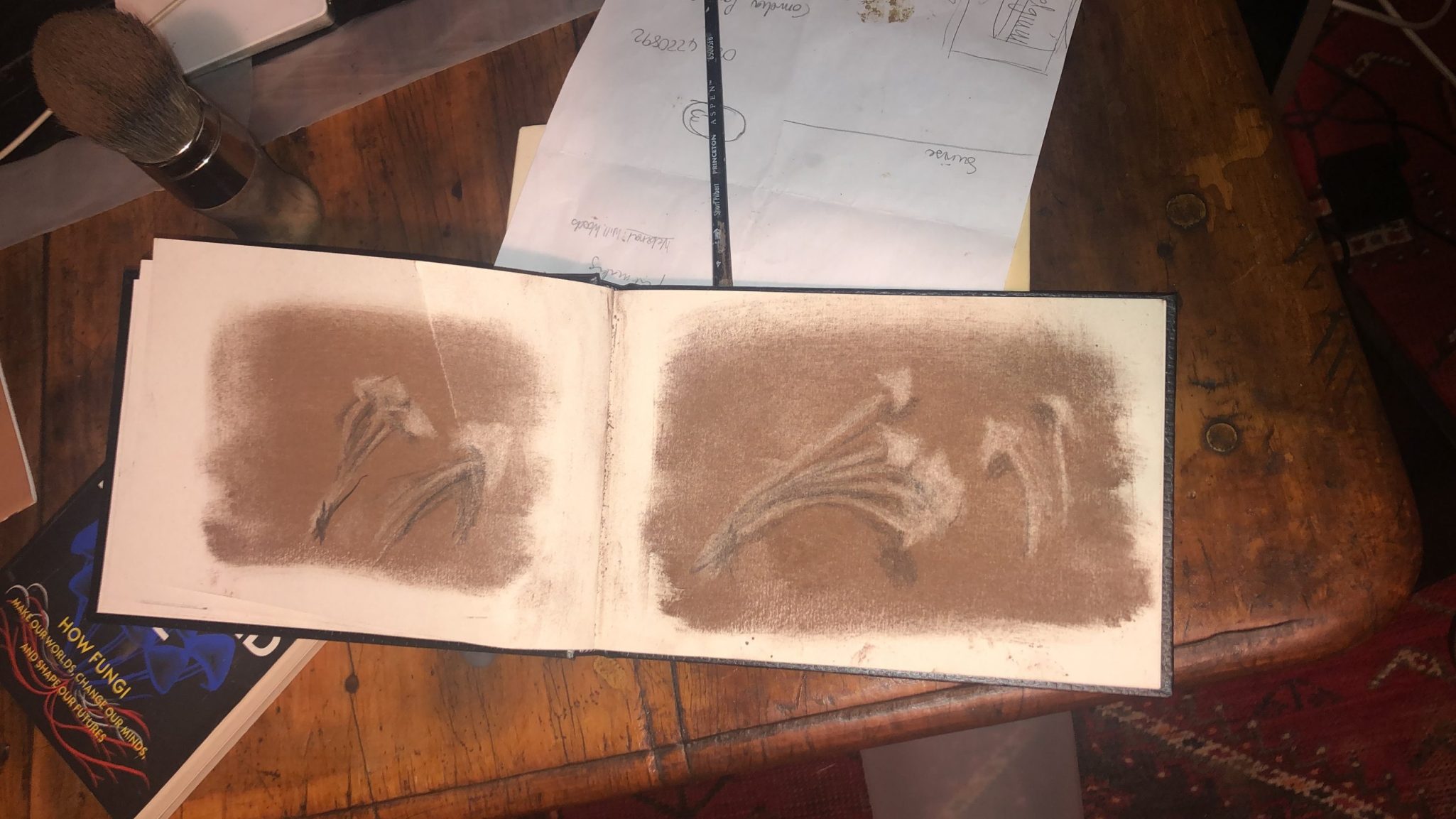
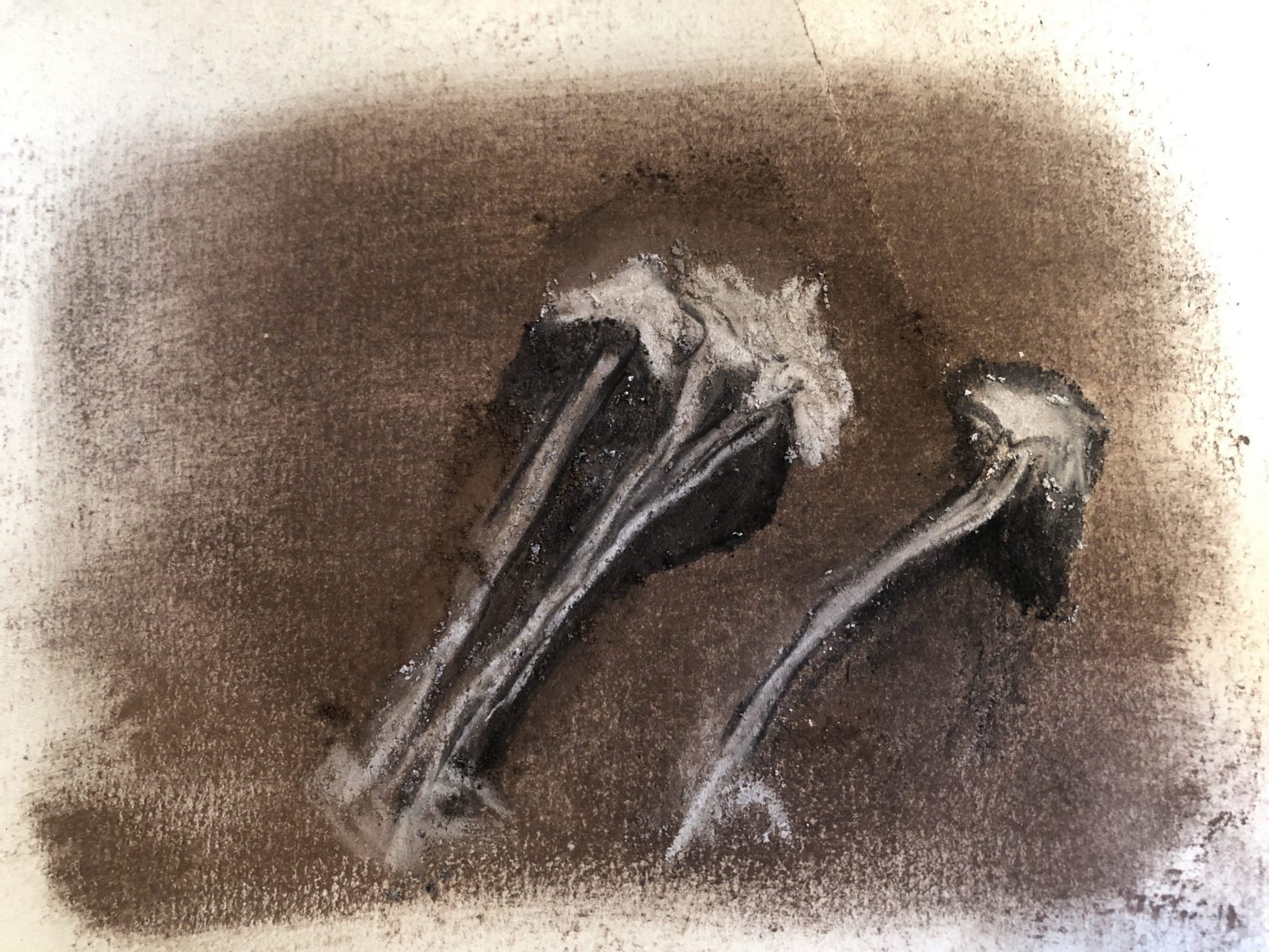
Making this work took me to the collaborative work I did with OCA student Annette Holtkamp earlier this year, which is now in the process of deconstruction and will hopefully decompose over time. I read about the work Strange Fruit (1999) in Documents of Contemporary Art (Ann Temkin p132 -134) The discussion is about vanitas and the subject of mortality. I have to consider how fungi embody or imply death, but in this case, how the work will be seen over time. I have come to a place where I have accepted that nature is more robust and that even my ideas of intervening at times, which I would call care concerns, are a way of trying to control the process. Annette and I have consented that the work is consumed or decays outside. We hoped fungi would do it, but we also must accept other natural occurrences during this disintegration. I must admit that it is outside and that I cannot always be physically available to control certain conditions or the time this process will take. I read that in the case of Strange Fruit, the process of slow disintegration became integral to the artwork and that it was also essential that this process stays visible inside the museum where it was displayed. I found it interesting that mould and insect damage had to be controlled due to the place (inside the museum) where this was happening. This is so different to our work, which is placed outside, where this is part of a natural decay process, as well as not on public display. Care of the work became a more significant concern when Ann Temkin left the museum, Philadelphia Museum of Art, where the work was kept.
Recently we had hot days, and I regularly watered the site. Then in the last week, there was a build-up of thunderstorms which led to overcast and cooler days, although the humidity was high. I visited the site to adjust the cover and found mushrooms started to pin. This happened within a few hours, and over the next few days, these mushrooms started growing in significant clusters. I wanted to protect it from the sun on the 3rd day, as I had been checking in on weather forecasts and new more rain was coming. I decided to put an umbrella over the site to protect the mushrooms from the sun. I removed the umbrella when the rain started pouring.
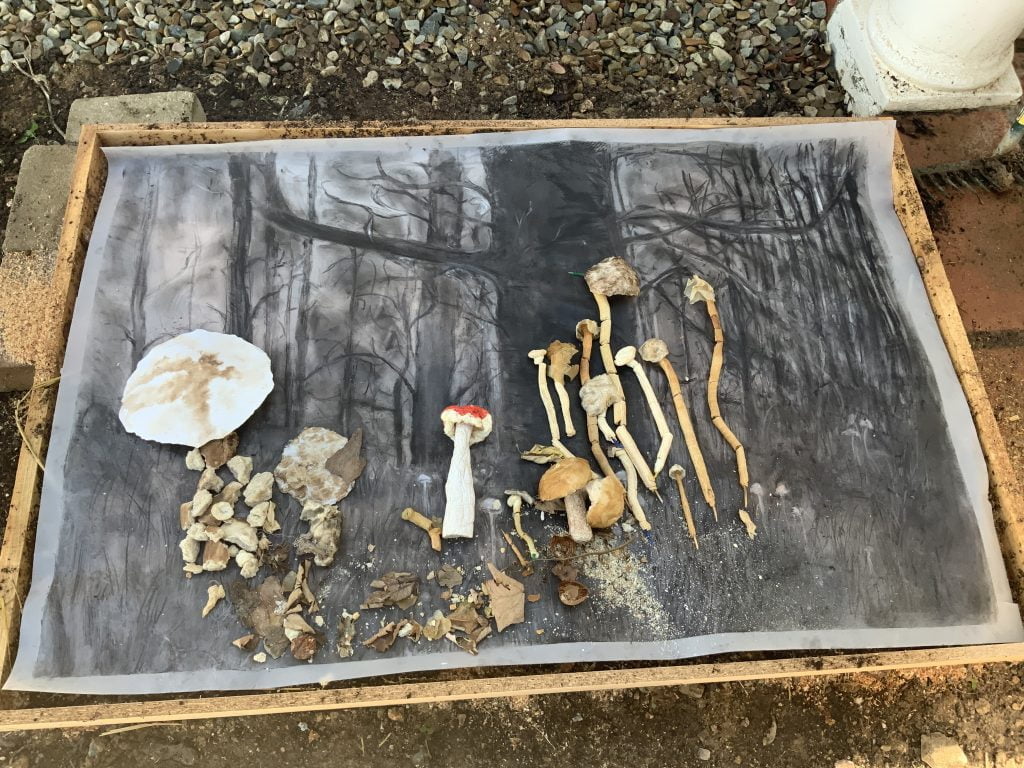
I wonder about a time-based working process, like video and photo documentation. Will this prevent communication or interaction around the work- a case that the narrative becomes linear? I keep video and photographic documentation in a file, but I have not done this as a daily routine.
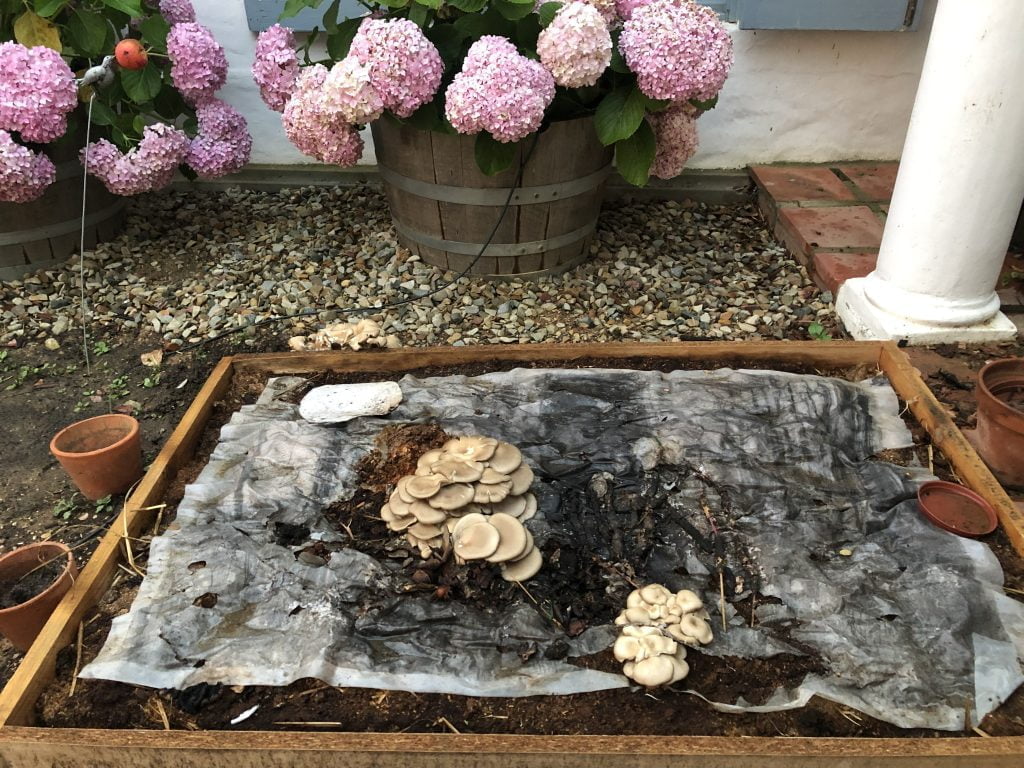
List of images
Bibliography
Temkin Ann, 1999 Strange Fruit Documents of Contemporary Art. MIT Press. page